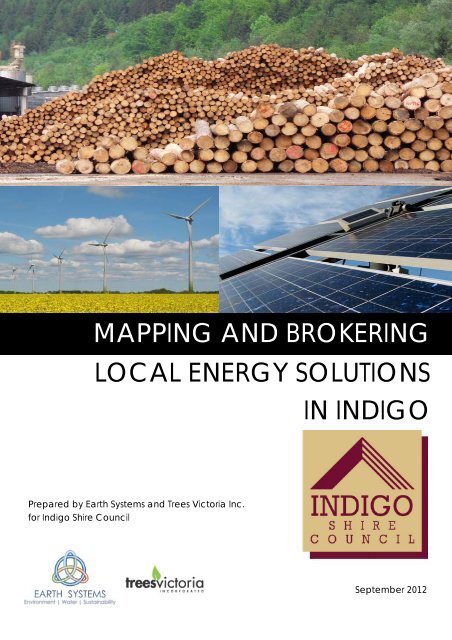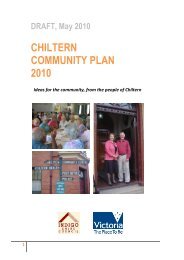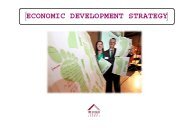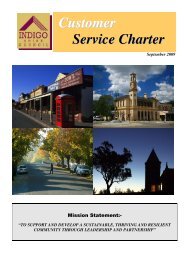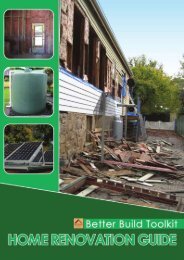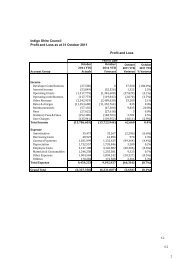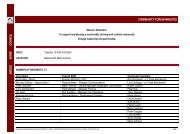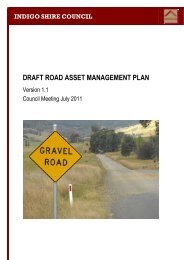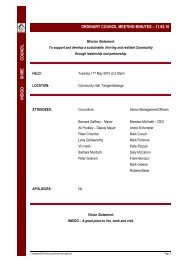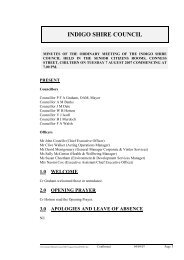Indigo Shire - renewable energy mapping - Indigo Shire Council
Indigo Shire - renewable energy mapping - Indigo Shire Council
Indigo Shire - renewable energy mapping - Indigo Shire Council
Create successful ePaper yourself
Turn your PDF publications into a flip-book with our unique Google optimized e-Paper software.
MAPPING AND BROKERING<br />
LOCAL ENERGY SOLUTIONS<br />
IN INDIGO<br />
Prepared by Earth Systems and Trees Victoria Inc.<br />
for <strong>Indigo</strong> <strong>Shire</strong> <strong>Council</strong><br />
September 2012
LOCAL ENERGY SOLUTIONS IN<br />
INDIGO SHIRE: RENEWABLE<br />
ENERGY RESOURCE SURVEY<br />
Victoria, Australia<br />
Prepared for<br />
INDIGO SHIRE COUNCIL<br />
By<br />
SEPTEMBER 2012
Earth Systems<br />
Mapping and Brokering Local Energy Solutions in <strong>Indigo</strong> <strong>Shire</strong><br />
DISTRIBUTION RECORD<br />
Copy No. Company / Position Name<br />
DOCUMENT REVISION LIST<br />
Revision<br />
Status/Number<br />
Revision Date Description of Revision Approved By<br />
RevDRAFT 2 nd July 2012 Draft for Initial Client Feedback Dr John Sanderson<br />
Rev0 7 th Sep 2012 Final Dr Adrian Morphett<br />
This report is not to be used for purposes other than those for which it was intended. Environmental<br />
conditions change with time. The information in this report is based on observations made during site<br />
visits and on the best publically available data at the time of writing. Where this report is to be made<br />
available, either in part or in its entirety, to a third party, Earth Systems reserves the right to review the<br />
information and documentation contained in the report and revisit and update findings, conclusions and<br />
recommendations. Earth Systems does not warrant that this document is definitive nor free from error and<br />
does not accept liability for any loss caused or arising from reliance upon information provided herein.<br />
ISC1240_Phase_1_Report_Rev0_public report 1
Earth Systems<br />
Mapping and Brokering Local Energy Solutions in <strong>Indigo</strong> <strong>Shire</strong><br />
Executive Summary<br />
<strong>Indigo</strong> <strong>Shire</strong> has commissioned Earth Systems to provide a broad evaluation of <strong>Shire</strong>-wide <strong>renewable</strong><br />
<strong>energy</strong> options to support the <strong>Shire</strong>’s electrical <strong>energy</strong> needs for the future. The study considers realistic<br />
resource options for a transition to locally-based <strong>energy</strong> generation for the equivalent electrical demands<br />
of 13,000 households out to 2050. This equates to an installed generation capacity of about 13 MW e .<br />
The study constitutes Phase 1 of a 2 part program funded through the Victorian Government’s<br />
Sustainability Accord Programme:<br />
Phase 1 - a survey of <strong>renewable</strong> <strong>energy</strong> resources in the region and development potential;<br />
Phase 2 - a detailed report evaluating the potential of bio<strong>energy</strong> in the region specifically.<br />
This document reports the results of Phase 1 of the study, some findings from which will help to define<br />
the scope of Phase 2.<br />
The objective of Phase 1 was to evaluate in a desktop study the extent of the <strong>renewable</strong> <strong>energy</strong><br />
resources within <strong>Indigo</strong> <strong>Shire</strong>, including solar, wind, geothermal, hydroelectric and biomass resources.<br />
Utilising information on the current state of the relevant technologies, geophysical and topographical data<br />
and other information resources relevant to the <strong>Shire</strong>, the likely cost and technical feasibility of <strong>renewable</strong><br />
<strong>energy</strong> deployment in the <strong>Shire</strong> has been reviewed.<br />
Study Inputs<br />
Key inputs to the study were:<br />
<br />
<br />
<br />
<br />
<br />
<br />
<br />
<br />
<br />
Electricity grid infrastructure and capacity for embedded generation in and near to the <strong>Shire</strong><br />
Major electricity consumers within or near to the <strong>Shire</strong><br />
Land uses and exclusions which would affect where a new <strong>renewable</strong> <strong>energy</strong> project is located<br />
<strong>Shire</strong>-wide solar data<br />
<strong>Shire</strong>-wide wind data<br />
Geothermal resource review<br />
Hydropower resource review<br />
Waste biomass availability in and near to <strong>Shire</strong><br />
Potential for <strong>energy</strong> cropping within <strong>Indigo</strong> <strong>Shire</strong>.<br />
Exclusions<br />
The study did not consider:<br />
<br />
<br />
<br />
Thermal-only <strong>energy</strong> requirements (although co-generation of electricity and heat has been<br />
discussed with regards to specific industrial sites)<br />
Transport <strong>energy</strong> (eg local fuel production)<br />
Energy efficiency measures.<br />
Resource Data Analysis<br />
The various <strong>renewable</strong> resources available to <strong>Indigo</strong> <strong>Shire</strong> were analysed in a variety of ways, depending<br />
on the type of <strong>renewable</strong> resource data available and the type of technology to utilise them. In the case<br />
of geothermal and hydropower resources, no detailed resource analysis or modelling was undertaken as<br />
these do not appear to be viable for large-scale generation within the <strong>Shire</strong>. Biomass resources were<br />
ISC1240_Phase_1_Report_Rev0_public report 2
Earth Systems<br />
Mapping and Brokering Local Energy Solutions in <strong>Indigo</strong> <strong>Shire</strong><br />
analysed based on aggregated data for current land use and available waste streams. Full details of the<br />
resource analyses and data interpretation for wind and solar are provided in the Appendices to this report.<br />
Financial Modelling<br />
As a first-pass assessment of the economics of various <strong>renewable</strong> generation types, the resource data<br />
(where applicable) was used as input to financial models based on currently available generation<br />
technology, to determine typical economic performance of a given <strong>renewable</strong> generator located in the<br />
<strong>Shire</strong>. Models for wind and solar generation were based on nameplate generation at scales of 1.5, 10<br />
and 20 megawatts, to correspond with current (1.5 and 10 MW e ) grid capabilities and a larger-scale plant<br />
possible assuming some future grid capacity increase (20 MW e ). Models for bio<strong>energy</strong> were based on<br />
the scales relevant to current plausible cogeneration sites (Uncle Toby’s and Murray Goulburn), and a<br />
potential single generator equivalent to whole-of-<strong>Shire</strong> demand (13 MW e ).<br />
The specific economic performance for a given scenario was summarised in terms of a Levelised Cost of<br />
Energy (LCOE) expressed in dollars per megawatt hour ($/MWh e ), and an example payback period<br />
based on a grid-connected scenario with Large-scale Generation Certificates (LGC) has been provided.<br />
Note that the non-grid-connected (“islanded” or “behind the fence”) generation scenario was not explicitly<br />
modelled in this report as this is best considered on a specific case-by-case basis. However it is to be<br />
expected that where such an opportunity exists, the economic incentive will be much greater than for a<br />
grid-export arrangement. The LCOE calculated in this report can still be used as a basis for selecting<br />
projects and making investment decisions in either case.<br />
Key Findings:<br />
Key findings of this Phase 1 Study are as follows:<br />
Electricity Grid<br />
The grid in <strong>Indigo</strong> <strong>Shire</strong> is constrained, being fed from a number of out-of-<strong>Shire</strong> zone and terminal<br />
stations. This puts significant limits on the scale of generation which can be installed at any given<br />
location within the <strong>Shire</strong>. Discussions with network operator SP-Ausnet identified that generation into the<br />
grid at approximately the 1 MW e scale may be possible at the main load centres (regional towns and key<br />
industry), namely:<br />
<br />
<br />
<br />
<br />
<br />
<br />
Chiltern<br />
Beechworth<br />
Yackandandah<br />
Rutherglen<br />
Tangambalanga (Murray Goulburn Dairy Co-op)<br />
Wahgunyah (Uncle Toby’s)<br />
Grid connection of less than 1.5 MW e has less connection infrastructure requirements, (inter-trips are not<br />
mandatory), and may represent a possible “sweet spot” for generator size.<br />
Larger-scale generation (approximately 10 MW e scale) may be possible at several locations just outside<br />
of the <strong>Shire</strong>, namely:<br />
<br />
<br />
<br />
Barnawartha (Logic Centre)<br />
Wodonga (near sub-station)<br />
Myrtleford (Carter Holt Harvey)<br />
Network constraints at the Wangaratta and Myrtleford substations may be remediated by locating new<br />
generators along these respective network loops, namely:<br />
ISC1240_Phase_1_Report_Rev0_public report 3
Earth Systems<br />
Wahgunyah (on the Wangaratta line)<br />
Rutherglen (on the Wangaratta line)<br />
Myrtleford<br />
Mapping and Brokering Local Energy Solutions in <strong>Indigo</strong> <strong>Shire</strong><br />
In certain circumstances, a proposed generator at these locations could negotiate better financial<br />
arrangements with the network operator if network upgrades can be postponed or avoided.<br />
Land Use<br />
An analysis of the location of national and regional parks, areas of cultural significance and mountainous<br />
areas unsuitable for development was undertaken. In general, the North West parts of the <strong>Shire</strong> would<br />
be more favourable for project development than the South East. The North West regions of the <strong>Shire</strong><br />
are also closer to the major load centres.<br />
Renewable Energy – Key Outcomes In Brief<br />
Solar: The technology exists, the resource is good enough, and opportunities exist for grid connection in<br />
the North West. The economics are not compelling at present, but a combination of factors may alter the<br />
economic equation in the short to medium term. The <strong>Shire</strong> should carefully watch the space and develop<br />
a strategy to capitalise on the opportunity for large-scale solar when the economics improve. In the<br />
meantime, generation of less than 100 kW e in Victoria is currently eligible for a recently reduced rate of 8<br />
c/kWh feed-in-tariff. (<strong>Indigo</strong> <strong>Shire</strong> may consider facilitating the installation of a number of 99.9 kW e solar<br />
PV systems on suitable roof areas as an immediate form of local generation.)<br />
Wind: Overall, the resource is marginal, but specific low-speed turbines may be able to capitalise on it.<br />
The economics are expected to be very sensitive to actual wind velocity at these low speeds. Payback<br />
periods are, however, better than solar due to lower capital equipment cost and better capacity factor.<br />
Wind data available may not accurately characterise particularly localised, higher-than-average wind<br />
velocity resources peculiar to specific land topography within the <strong>Shire</strong>, and local knowledge should be<br />
evaluated. The <strong>Shire</strong> should also consider engagement opportunities with other regions in which wind<br />
resources are more significant.<br />
Biomass: At present, about 3.4 MW e of generation is possible from the recovery of absolutely all<br />
available waste biomass in the entire <strong>Shire</strong> (including agricultural wastes). Energy crops, waste from<br />
forest fuel reduction, and/or a significant import of biomass from outside the <strong>Shire</strong> would be needed to<br />
provide a significant bio<strong>energy</strong> contribution. Significant (but currently fully utilised) plantation waste<br />
resources exist just beyond <strong>Shire</strong> boundaries, equating to a maximum power generation of about 8.3<br />
MW e . To generate the whole-of-<strong>Shire</strong> target of 13 MW e , an area of approximately 16,100 Ha would be<br />
required under a solid block of short rotation coppice cropping (SCC) scheme. Under an inter-cropping<br />
SCC scenario this would become 132,000 ha. Depending on the scenarios, bio<strong>energy</strong> plant economic<br />
modelling at the small, medium and large generating capacity had LCOEs of 185, 118 and 110 $/MWh e<br />
including electricity and thermal heat sales. Possible co-generation opportunities exist at a number of<br />
sites within the region, including Uncle Toby’s and Murray Goulburn, provided their existing waste<br />
resources could be augmented by additional biomass. These and several other sites are to be addressed<br />
in further detail in Phase 2 of the project.<br />
Geothermal: No significant geothermal resource is indicated in <strong>Indigo</strong> <strong>Shire</strong>. The existing data is limited,<br />
so the finding should be re-visited in the event that a new dataset for the region is developed.<br />
Hydropower: Large-scale hydro in and near to the <strong>Shire</strong> appears to have been fully exploited. Some<br />
small-scale (e.g. < 1 MW e ) resources exist in the <strong>Shire</strong>, however they are mostly associated with areas of<br />
cultural significance. There may be justification for individual small-scale projects, but these lie outside<br />
the scope of this Study.<br />
ISC1240_Phase_1_Report_Rev0_public report 4
Earth Systems<br />
Suggested Priorities for Decision Making<br />
Mapping and Brokering Local Energy Solutions in <strong>Indigo</strong> <strong>Shire</strong><br />
Reviewing the variety of resource potentials, generation costs and grid constraints presented in the<br />
preceding sections, it is possible to make some general observations on how a total generation output of<br />
13 MW e may be accomplished within the <strong>Indigo</strong> <strong>Shire</strong> region.<br />
<br />
<br />
<br />
<br />
<br />
<br />
<br />
There is little economy of scale benefit in going larger within the range of generation considered,<br />
other than for bio<strong>energy</strong> plant. Therefore, generation scale is likely to be dictated by network<br />
capacity (i.e. largest generator that can be connected without major network infrastructure costs).<br />
There are significant economic benefits in generation resulting in avoided retail power purchase.<br />
There are significant economic benefits in co-generation (possibly even tri-generation) at a given<br />
site.<br />
There may be additional incentives for installing site generation if it avoids the need for the<br />
network operator to undertake other infrastructure upgrades.<br />
Although the resource is marginal, the LCOE of wind means it is an attractive option..<br />
Where substantial cooling loads are present, there may be additional economic benefit in<br />
generating power from solar resources.<br />
If the majority of the biomass is to be purpose-grown (<strong>energy</strong> crops), the same basic generation<br />
equipment type can be used at all sites; and it may be advantageous to use a similar plant size<br />
and/or supplier to achieve capital cost reductions (multiple units purchase via consortium).<br />
Recommendations and Next Steps<br />
Overall recommendations from the Phase 1 Study are as follows.<br />
Solar<br />
Wind<br />
1. Maintain a watching brief on current technology costs, which are reducing rapidly.<br />
2. Consider any immediate opportunities for solar PV generation of less than 100 kW e , which in<br />
Victoria are currently eligible for a feed-in tariff (FIT) of 8 c/kWh (which for solar PV may not be<br />
commercially viable).<br />
3. Consider large-scale solar at specific sites where peak generation may be able to off-set large<br />
peaking cooling loads (large refrigeration loads such as refrigerated distribution centre, large<br />
winery or dairy).<br />
1. Consider whether local information can identify any specific locations that would yield a better<br />
resource (than currently mapped).<br />
2. The <strong>Shire</strong> should also consider engagement opportunities with other regions in which wind<br />
resources are more significant.<br />
3. Keep a watching brief on low-speed turbine developments.<br />
Geothermal<br />
1. Re-consider only if new geothermal data becomes available.<br />
Hydropower<br />
1. Consider limited possibilities for small-scale hydropower generation (
Earth Systems<br />
Mapping and Brokering Local Energy Solutions in <strong>Indigo</strong> <strong>Shire</strong><br />
2. Clarify availability and price of glycerol from Australian Biodiesel Producers (Barnawartha). If<br />
favourable, investigate possibility of biodigester cogeneration plant at Uncle Toby’s (Wahgunyah),<br />
Rivalea (Corowa), or Murray Goulburn (Tangambalanga).<br />
3. Contact plantation operators to further investigate nearby out-of-<strong>Shire</strong> plantation waste resources<br />
including typical transport routes, likely future availability and prices.<br />
4. Evaluate possible short rotation cropping systems suited to the <strong>Shire</strong> soil and climate, and<br />
evaluate practical extent suitable for integration with existing farming practices.<br />
5. Contact large industries in and around <strong>Shire</strong> as specified in Table 8-12 to confirm cogeneration<br />
and/or tri-generation opportunities.<br />
6. Prioritise detailed site co/tri-generation investigation(s) based on the individual site specifics.<br />
In Conclusion - A Possible Generation Mix<br />
The following table summarises a possible generation mix, taking into account the suggested generation<br />
mix priorities, network characteristics, major consumers, LCOE, possible cogeneration sites and sites<br />
with peak cooling loads. The table is not prescriptive, and is intended only to suggest a potential shortlist<br />
of generation possibilities from which a total of 13 MW e could be selected. The list would be subject to<br />
much refinement upon obtaining further detailed information from a number of the industrial sites, which<br />
will be considered in detail during Phase 2. (Although some attempt has been made to list the generation<br />
options in order of merit, this is likely to be arbitrary, pending further site specific technical and economic<br />
details to be obtained in Phase 2.)<br />
Table – Possible inclusions in a future <strong>renewable</strong> generation mix for <strong>Indigo</strong> <strong>Shire</strong><br />
Resource<br />
Type<br />
Quality<br />
available<br />
in <strong>Indigo</strong><br />
Suggested<br />
Location(s)<br />
Approx.<br />
LCOE<br />
($/MWh e )<br />
Suggested<br />
Capacity*<br />
(MW e )<br />
Comments<br />
Biomass<br />
Energy<br />
crops /<br />
Imports<br />
Carter Holt<br />
Harvey<br />
Myrtleford<br />
118 6<br />
(6)<br />
<br />
<br />
<br />
Retail off-set<br />
incentive;<br />
Co-gen Incentive;<br />
Network benefits<br />
Biomass<br />
Site waste<br />
+ Energy<br />
crops /<br />
Imports<br />
Murray Goulburn<br />
Tangambalanga<br />
118 6<br />
(6)<br />
<br />
<br />
Retail off-set<br />
incentive;<br />
Co/Tri-gen incentive;<br />
Biomass<br />
Site waste<br />
+ Energy<br />
crops /<br />
Imports<br />
Uncle Toby’s<br />
Wahgunyah<br />
185 2<br />
(2)<br />
<br />
<br />
<br />
Retail off-set<br />
incentive;<br />
Co-gen incentive;<br />
Network benefits<br />
Biomass<br />
Energy<br />
crops /<br />
Imports<br />
Logic Centre<br />
Barnawartha<br />
118 6<br />
(6)<br />
<br />
<br />
Retail off-set<br />
incentive;<br />
Co/Tri-gen Incentive<br />
Wind Marginal Various, eg<br />
Chiltern,<br />
Beechworth,<br />
Yackandandah<br />
Wodonga<br />
124 4.5<br />
(1.5)<br />
<br />
<br />
LCOE very sensitive<br />
to actual wind velocity<br />
Seek best possible<br />
resource(s) at<br />
available grid<br />
ISC1240_Phase_1_Report_Rev0_public report 6
Earth Systems<br />
Mapping and Brokering Local Energy Solutions in <strong>Indigo</strong> <strong>Shire</strong><br />
Resource<br />
Type<br />
Quality<br />
available<br />
in <strong>Indigo</strong><br />
Suggested<br />
Location(s)<br />
Approx.<br />
LCOE<br />
($/MWh e )<br />
Suggested<br />
Capacity*<br />
(MW e )<br />
Comments<br />
connection locales<br />
Solar PV Good Rutherglen 204 1.5<br />
(0.3)<br />
<br />
<br />
Network benefits<br />
May complement<br />
large refrigeration<br />
loads (winery)<br />
Solar CST Good Logic Centre<br />
Barnawartha<br />
298 20<br />
(5.4)<br />
<br />
Possible<br />
biomass/CST hybrid<br />
would reduce LCOE<br />
<br />
May complement<br />
large refrigeration<br />
loads (distribution<br />
centre)<br />
*Rated Capacity (Average actual generated power taking into account capacity factor)<br />
ISC1240_Phase_1_Report_Rev0_public report 7
Earth Systems<br />
Contents<br />
Mapping and Brokering Local Energy Solutions in <strong>Indigo</strong> <strong>Shire</strong><br />
Executive Summary ...................................................................................................... 2<br />
1 Background, Objectives and Scope .................................................................. 21<br />
1.1 Background ........................................................................................................................... 21<br />
1.2 Objectives and Scope ........................................................................................................... 21<br />
1.2.1 Exclusions .............................................................................................................................................. 21<br />
2 <strong>Shire</strong> Electric Grid Infrastructure ....................................................................... 22<br />
2.1 Introduction ........................................................................................................................... 22<br />
2.1.1 Electricity Generation in Victoria ..................................................................................................... 22<br />
2.2 State of the Network ............................................................................................................. 22<br />
2.2.1 Network ................................................................................................................................................... 22<br />
2.2.2 Current and Forecast Grid Loads ................................................................................................... 24<br />
2.3 Legislative and Regulatory Requirements ......................................................................... 25<br />
2.3.1 Administrative Organisation ............................................................................................................. 25<br />
2.3.2 Scheduled vs. Unscheduled Generation ..................................................................................... 25<br />
2.4 Analysis ................................................................................................................................. 26<br />
2.4.1 Grid Connected vs. Islanded Generation .................................................................................... 26<br />
2.4.2 Potential Opportunities ...................................................................................................................... 26<br />
2.4.3 Barriers to Implementation ............................................................................................................... 28<br />
2.5 Conclusions and Recommendations .................................................................................. 29<br />
3 Major Regional Electricity Consumers .............................................................. 30<br />
3.1 Current and Forecast Demand ............................................................................................ 30<br />
3.1.1 Residential ............................................................................................................................................. 30<br />
3.1.2 Commercial and Institutional ........................................................................................................... 31<br />
3.1.3 Industrial ................................................................................................................................................. 31<br />
4 Land Analysis ...................................................................................................... 33<br />
4.1 Geographical Features ......................................................................................................... 33<br />
4.2 Farming Zone in <strong>Indigo</strong> <strong>Shire</strong> .............................................................................................. 34<br />
4.3 Areas of Cultural Significance ............................................................................................. 35<br />
5 Modelling Methodology ...................................................................................... 38<br />
5.1 Energy Generation Modelling .............................................................................................. 38<br />
5.1.1 Electricity Pricing ................................................................................................................................. 38<br />
5.1.2 Network Charges ................................................................................................................................. 39<br />
5.1.3 Transmission Costs ............................................................................................................................ 39<br />
5.1.4 Selected Capacities ............................................................................................................................ 39<br />
5.2 Simple Economic Modelling ................................................................................................ 39<br />
5.2.1 Levelised Cost of Energy .................................................................................................................. 40<br />
6 Solar Power ......................................................................................................... 42<br />
ISC1240_Phase_1_Report_Rev0_public report 8
Earth Systems<br />
Mapping and Brokering Local Energy Solutions in <strong>Indigo</strong> <strong>Shire</strong><br />
6.1 Overview ................................................................................................................................ 42<br />
6.2 Solar Energy Technology ..................................................................................................... 45<br />
6.2.1 Solar Photovoltaic Systems ............................................................................................................. 45<br />
6.2.2 Concentrating Solar Thermal ........................................................................................................... 50<br />
6.2.3 Concentrating Photovoltaic (CPV) ................................................................................................. 55<br />
6.2.4 Environmental Impact ........................................................................................................................ 57<br />
6.3 Solar Resources in <strong>Indigo</strong> .................................................................................................... 58<br />
6.3.1 Solar Resource Characterisation Methodology ......................................................................... 62<br />
6.3.2 Model Parameters ............................................................................................................................... 63<br />
6.3.3 Modelling Results ................................................................................................................................ 64<br />
6.4 Conclusions and Recommendations .................................................................................. 70<br />
7 Wind Power .......................................................................................................... 72<br />
7.1 Wind Technology Review ..................................................................................................... 72<br />
7.1.1 Horizontal Axis Wind Turbine (HAWT) ......................................................................................... 74<br />
7.1.2 Vertical Axis Wind Turbine (VAWT)............................................................................................... 75<br />
7.1.3 Technology costs and economics .................................................................................................. 76<br />
7.1.4 Environmental Impact ........................................................................................................................ 77<br />
7.2 Wind Resources in <strong>Indigo</strong> .................................................................................................... 77<br />
7.3 Wind Opportunities in <strong>Indigo</strong> ............................................................................................... 81<br />
7.3.1 Wind Resource Characterisation Methodology ......................................................................... 81<br />
7.3.2 Modelling Results ................................................................................................................................ 82<br />
7.4 Conclusions and Recommendations .................................................................................. 87<br />
8 Bio<strong>energy</strong>............................................................................................................. 89<br />
8.1 Bio<strong>energy</strong> Introduction ........................................................................................................ 90<br />
8.1.1 What is Biomass .................................................................................................................................. 90<br />
8.1.2 What is Bio<strong>energy</strong>? ............................................................................................................................. 90<br />
8.1.3 Bio<strong>energy</strong> Status: Global, Australia and Victoria ..................................................................... 92<br />
8.2 Bio<strong>energy</strong> Technology ......................................................................................................... 96<br />
8.2.1 Gasification ............................................................................................................................................ 97<br />
8.2.2 Combustion ........................................................................................................................................... 99<br />
8.2.3 Pyrolysis ............................................................................................................................................... 103<br />
8.2.4 Anaerobic Digestion ......................................................................................................................... 104<br />
8.3 Comparative Technology Costs and Maturity ................................................................. 104<br />
8.4 Biomass Resources in <strong>Indigo</strong> <strong>Shire</strong>.................................................................................. 107<br />
8.4.1 Current Land Use and Production ............................................................................................... 107<br />
8.4.2 Waste Biomass Resources in <strong>Indigo</strong> <strong>Shire</strong> ............................................................................... 109<br />
8.4.3 Hancock Victorian Plantations (HVP) ......................................................................................... 110<br />
8.4.4 Residential Organics Greenwaste Collection and Transfer Station .................................. 111<br />
8.4.5 Municipal Solid Waste (MSW)....................................................................................................... 112<br />
8.4.6 Waste biomass resource – <strong>energy</strong> and electricity generation potential .......................... 112<br />
ISC1240_Phase_1_Report_Rev0_public report 9
Earth Systems<br />
Mapping and Brokering Local Energy Solutions in <strong>Indigo</strong> <strong>Shire</strong><br />
8.5 Bio<strong>energy</strong> Cropping Opportunities ................................................................................... 114<br />
8.5.1 Short-rotation coppice cropping (SCC) and inter-cropping bio<strong>energy</strong> ............................. 115<br />
8.6 High Energy Demand Users ............................................................................................... 120<br />
8.6.1 Murray Goulburn Kiewa (Tangambalanga) ............................................................................... 123<br />
8.6.2 Uncle Toby’s (Wahgunyah) ............................................................................................................ 123<br />
8.7 Bio<strong>energy</strong> Modelling Targets ............................................................................................. 124<br />
8.8 Conclusions and Recommendations ................................................................................ 130<br />
9 Geothermal Energy ........................................................................................... 132<br />
9.1 Geothermal Technology Review ....................................................................................... 132<br />
9.1.1 Technology Costs and Economics .............................................................................................. 133<br />
9.1.2 Environmental Impact ...................................................................................................................... 133<br />
9.2 Geothermal Resources in <strong>Indigo</strong>....................................................................................... 134<br />
9.3 Geothermal Opportunities in <strong>Indigo</strong> ................................................................................. 135<br />
10 Hydropower ....................................................................................................... 136<br />
10.1 Hydropower Technology .................................................................................................... 136<br />
10.1.1 Technology Costs and Economics ............................................................................................ 137<br />
10.1.2 Environmental Impact .................................................................................................................... 138<br />
10.2 Hydropower Resources in Victoria ................................................................................... 138<br />
10.3 Hydropower Opportunities in <strong>Indigo</strong> ................................................................................ 139<br />
11 Conclusions ....................................................................................................... 141<br />
12 Recommendations ............................................................................................ 144<br />
13 References ......................................................................................................... 146<br />
Appendices<br />
Appendix A:<br />
Appendix B:<br />
Appendix C:<br />
Appendix D:<br />
Appendix E:<br />
Electricity Demand – target setting for <strong>Indigo</strong> <strong>Shire</strong><br />
Solar photovoltaic (PV) and concentrated solar thermal (CST) – Technology review,<br />
detailed meteorological GIS <strong>mapping</strong>, detailed costings and references<br />
Wind– Technology review, detailed costings and references<br />
Biomass – Detailed costings and references<br />
Errata – reviewers comments<br />
ISC1240_Phase_1_Report_Rev0_public report 10
Earth Systems<br />
Mapping and Brokering Local Energy Solutions in <strong>Indigo</strong> <strong>Shire</strong><br />
Figures<br />
Figure 2.1: Representation of the Electricity Delivery Model [6] .......................................................... 23<br />
Figure 2.2: High Voltage Shared Electricity Network in Victoria [] ...................................................... 23<br />
Figure 2.3: SP Ausnet supply areas and terminal and zone substations in <strong>Indigo</strong> <strong>Shire</strong> area [6] .... 24<br />
Figure 2.4: Location of Wodonga Logic Centre with respect to other <strong>Indigo</strong> load centres .............. 27<br />
Figure 2.5: Connection Process for Medium-scale Distributed Generation [2] .................................. 28<br />
Figure 3.1: Population map of <strong>Indigo</strong> <strong>Shire</strong> ............................................................................................ 31<br />
Figure 3.2: Location of major towns and major industrial <strong>energy</strong> consumers (~1 MW e shown in<br />
white (including towns), ~10 MW e shown in red) ......................................................... 32<br />
Figure 4.1: Map of Park and Forest Areas in <strong>Indigo</strong> <strong>Shire</strong> .................................................................... 33<br />
Figure 4.2: Mountainous areas in <strong>Indigo</strong> <strong>Shire</strong> ...................................................................................... 34<br />
Figure 4.3: Farming zone in <strong>Indigo</strong> <strong>Shire</strong> ................................................................................................ 35<br />
Figure 4.4: Map of Areas of Cultural Significance in <strong>Indigo</strong> <strong>Shire</strong> ....................................................... 36<br />
Figure 4.5: Land constraint areas from combined sources in <strong>Indigo</strong> <strong>Shire</strong> ........................................ 37<br />
Figure 5.1: Levelised Cost of Energy [14] ............................................................................................... 40<br />
Figure 6.1: Worldwide annual global solar exposure in kWh/m 2 []....................................................... 42<br />
Figure 6.2: Annual average daily global solar exposure ....................................................................... 43<br />
Figure 6.3: Annual average daily direct normal solar exposure........................................................... 43<br />
Figure 6.4: Rutherglen Daily Global Solar Exposure by Month and Annual Average [] .................... 44<br />
Figure 6.5: Solar operating plants with capacity of more than 30 kW e [] ............................................ 45<br />
Figure 6.6: Martifer Solar PV array (left) []; Schematic of PV Solar generation system (right) []...... 45<br />
Figure 6.7: Installed capacity of Solar PV internationally and in Australia [26,]................................. 46<br />
Figure 6.8: Solar PV large scale installations in Australia [52] ............................................................ 47<br />
Figure 6.9: Australian PV module prices in current AUD [] .................................................................. 48<br />
Figure 6.10: PV System Capital Cost [] ................................................................................................... 48<br />
Figure 6.11: PV Levelised cost of <strong>energy</strong> [43] ........................................................................................ 49<br />
Figure 6.12: Balance of System Cost and Levelised Cost of Energy forecast [41]. .......................... 49<br />
Figure 6.13: Schematic of Typical Concentrating Solar Plant []........................................................... 50<br />
Figure 6.14: Australia Concentrating Solar Thermal plants [] .............................................................. 51<br />
Figure 6.15 World Installed Concentrating Solar Thermal [] ................................................................. 52<br />
Figure 6.16: Estimated LCOE dependence on system size (normalised to a 100 MWe system with 5<br />
hours’ storage) [50] ......................................................................................................... 52<br />
Figure 6.17 Estimated CSP cost / LCOE reductions (Reproduced from AT Kearney, 2010) [50] ...... 55<br />
ISC1240_Phase_1_Report_Rev0_public report 11
Earth Systems<br />
Mapping and Brokering Local Energy Solutions in <strong>Indigo</strong> <strong>Shire</strong><br />
Figure 6.18: Concentrating PV Dishes (top); Power Tower in Bridgwater VIC (bottom left);<br />
Concentrating PV System (bottom right) [,,] ................................................................. 56<br />
Figure 6.19: Solar <strong>energy</strong> components and concentrating system [,] ................................................. 59<br />
Figure 6.20: Annual average daily global exposure in <strong>Indigo</strong> <strong>Shire</strong> .................................................... 59<br />
Figure 6.21: January average daily global exposure in <strong>Indigo</strong> <strong>Shire</strong> (max. condition) ...................... 60<br />
Figure 6.22: June average daily global exposure in <strong>Indigo</strong> <strong>Shire</strong> (min. condition) ............................ 60<br />
Figure 6.23: Annual average daily direct normal solar exposure in <strong>Indigo</strong> <strong>Shire</strong> .............................. 61<br />
Figure 6.24: January average daily direct normal solar exposure in <strong>Indigo</strong> <strong>Shire</strong> (max. condition) 62<br />
Figure 6.25: June average daily direct normal solar exposure in <strong>Indigo</strong> <strong>Shire</strong> (min. condition) ...... 62<br />
Figure 6.26: Proposed areas for solar PV plants (representative areas for scale purposes only, not<br />
actual geographical location) ......................................................................................... 66<br />
Figure 6.27: Proposed areas for 20 MW e CST plant (representative areas for scale purposes only,<br />
not actual geographical location) .................................................................................. 66<br />
Figure 7.1: Total cumulative installed global wind capacity in MW e [70] ............................................ 72<br />
Figure 7.2: Installed wind capacity by state [70] .................................................................................... 73<br />
Figure 7.3: Wind large scale installations in Australia [52] ................................................................... 73<br />
Figure 7.4: Wind generators in Victoria (as of August 2011) [71]......................................................... 74<br />
Figure 7.5: Components making up a typical horizontal axis wind turbine [] .................................... 75<br />
Figure 7.6: Vertical Axis Wind Turbines: (a) Darrieus [73] and (b) Savonius wind turbines [] .......... 76<br />
Figure 7.7: Wind power cost projections based on various studies [14] ............................................ 77<br />
Figure 7.8: Victorian wind atlas (wind speed at 65 m) [84] ................................................................... 79<br />
Figure 7.9: Victorian wind map produced by Sustainability Victoria (65 m elevation) [84] ............... 79<br />
Figure 7.10: <strong>Indigo</strong> <strong>Shire</strong> wind speed map from the Wind Atlas produced by Sustainability Victoria<br />
(wind speed at 65 m elevation) [84] ............................................................................... 80<br />
Figure 7.11: Proposed areas for wind farms (representative areas for scale purposes only, not<br />
actual geographical location) ......................................................................................... 85<br />
Table 8.1: Summary of LCA bio<strong>energy</strong> scenarios vs current practice fossil fuel scenario from IEA<br />
Task 38 [102] .................................................................................................................... 91<br />
Figure 8.2: Shares of <strong>energy</strong> sources in total global primary <strong>energy</strong> supply in 2008 (492 EJ) [] ..... 92<br />
Figure 8.3: Shares of global primary biomass sources for <strong>energy</strong> in 2008 (50.3EJ) [103] ................ 92<br />
Figure 8.4: Share of primary <strong>energy</strong> sources in world electricity generation in 2008 [103] .............. 93<br />
Figure 8.5: Proportions of Energy Generated from Biomass for Selected Nations [100] .................. 93<br />
Figure 8.6: Bio<strong>energy</strong> electricity generation total for Australia [104] .................................................. 94<br />
Figure 8.7: Bio<strong>energy</strong> electricity generation by state in Australia [] ................................................... 95<br />
Figure 8.8: bio<strong>energy</strong> generators in Victoria []....................................................................................... 96<br />
Figure 8.9: Typical scales of various thermochemical conversion technologies [99] ....................... 97<br />
Figure 8.10: Schematic representation of a gasification process (adapted from []) ......................... 98<br />
Figure 8.11: Simple steam Rankine cycle (adapted from []) ............................................................... 100<br />
ISC1240_Phase_1_Report_Rev0_public report 12
Earth Systems<br />
Mapping and Brokering Local Energy Solutions in <strong>Indigo</strong> <strong>Shire</strong><br />
Figure 8.12: An ORC trigeneration process with wood as feedstock (adapted from []) .................. 101<br />
Figure 8.13: Simple Kalina cycle ............................................................................................................ 102<br />
Figure 8.14: the production of the solid fraction biochar from a slow pyrolysis process can result<br />
in a net removal of carbon from the atmosphere [] .................................................... 104<br />
Figure 8.15: Range in recent LCOE for commercially available <strong>renewable</strong> <strong>energy</strong> technologies in<br />
comparison to recent non-<strong>renewable</strong> <strong>energy</strong> costs. Technology subcategories and<br />
discount rates were aggregated [103] ......................................................................... 105<br />
Figure 8.16: Typical recent bio<strong>energy</strong> LCOE at a 7% discount rate, calculated over a year of<br />
feedstock costs, which differ between technologies. These costs do not include<br />
interest, taxes, depreciation and amortization [103] .................................................. 105<br />
Figure 8.17: Technology maturity states of bio<strong>energy</strong>: thermochemical (orange), and biochemical<br />
(blue), and for heat and power [103] ............................................................................ 106<br />
Figure 8.18: Biomass power generation technology maturity status [] ............................................ 107<br />
Figure 8.19: Tree density layers. Note: the area of the scattered tree layer within the <strong>Indigo</strong> <strong>Shire</strong><br />
boundary is 17,300 ha. .................................................................................................. 109<br />
Figure 8.20: Proposed layout of Mallee plantation on farmland......................................................... 115<br />
Figure 8.21: Energy cropping representative areas for scale purposes only at 2.5, 6 and 13 MW e<br />
requirements for solid short cycle cropping scenario .............................................. 116<br />
Figure 8.22: Energy inter-cropping representative areas for scale purposes only at 2.5 MWe<br />
requirements for short-rotation coppice cropping scenario .................................... 118<br />
Figure 8.23: Energy inter-cropping representative areas for scale purposes only at 6 MWe<br />
requirements for short-rotation coppice cropping scenario .................................... 119<br />
Figure 8.24: Energy inter-cropping representative areas for scale purposes only at 13 MWe<br />
requirements for short-rotation coppice cropping scenario .................................... 120<br />
Figure 8.25: sites of interest – potential biomass resource (green) or <strong>energy</strong> demand user (red), or<br />
both ................................................................................................................................. 121<br />
Figure 8.26: The Murray Goulburn retail milk and cream cheese processing facility located at 19<br />
Kiewa East Road, Tangambalanga, Victoria, 3691 ..................................................... 123<br />
Figure 8.27: The Uncle Toby’s breakfast cereals and foods processing facility located at 13 Talbot<br />
Rd Wahgunyah, VIC, 3687 ............................................................................................. 124<br />
Figure 9.1: Geothermal temperature at 1500 m [85] ............................................................................ 135<br />
Figure 10.1: Hydroelectric power generation [] .................................................................................... 136<br />
Figure 10.2: Hydro generators in Victoria [143] ................................................................................... 139<br />
Figure 10.3: Hydro Potential in Victoria and <strong>Indigo</strong> <strong>Shire</strong> ................................................................... 140<br />
ISC1240_Phase_1_Report_Rev0_public report 13
Earth Systems<br />
Tables<br />
Mapping and Brokering Local Energy Solutions in <strong>Indigo</strong> <strong>Shire</strong><br />
Table 2-1: Current and Forecast loads at relevant zone substations to 2015 [11] ............................. 24<br />
Table 2-2: Sub-transmission loop loads [7] ............................................................................................ 24<br />
Table 3-1: Estimated yearly <strong>energy</strong> consumption for Uncle Toby’s in Wahgunyah and Murray<br />
Goulburn Kiewa in Tangambalanga............................................................................... 32<br />
Table 5-1: Data and assumptions used for financial modelling ........................................................... 40<br />
Table 6-1: Example of commercial-scale CST plants in the world [50] ............................................... 53<br />
Table 6-2: Greenhouse Gas analysis of solar PV ................................................................................... 57<br />
Table 6-3: Greenhouse Gas analysis of CST .......................................................................................... 57<br />
Table 6-4: Solar System Modelling Parameters ..................................................................................... 63<br />
Table 6-5: Solar PV <strong>energy</strong> generation modelling results ..................................................................... 64<br />
Table 6-6: CST <strong>energy</strong> generation modelling results ............................................................................ 65<br />
Table 6-7: Data and results of key financial parameters (all in 2012 AU$) of solar PV 1.5 MW e ....... 67<br />
Table 6-8: Data and results of key financial parameters (all in 2012 AU$) of solar PV 10 MW e ........ 67<br />
Table 6-9: Data and results of key financial parameters (all in 2012 AU$) of solar PV 20 MW e ........ 68<br />
Table 6-10: Data and results of key financial parameters (all in 2012 AU$) of CST 20 MW e ............. 69<br />
Table 7-1: GHG analysis of wind farm ..................................................................................................... 77<br />
Table 7-2: Energy generation potential in <strong>Indigo</strong> <strong>Shire</strong> and surrounding area at 120 m elevation<br />
[86,87,88] ........................................................................................................................... 82<br />
Table 7-3: Energy demand data and required <strong>energy</strong> generation results ........................................... 83<br />
Table 7-4: Key Financial Data and Results for wind farm at 1.5 MW e .................................................. 85<br />
Table 7-5: Key Financial Data and Results for wind farm at 10 MW e ................................................... 86<br />
Table 7-6: Key Financial Data and Results for wind farm at 20 MW e ................................................... 86<br />
Table 8-1: Fuel requirements versus gasifier design ............................................................................ 98<br />
Table 8-2: Technical data of Lienz I and Lienz II .................................................................................. 102<br />
Table 8-3: Major uses of land ................................................................................................................. 107<br />
Table 8-4: Agriculture production by crop type ................................................................................... 107<br />
Table 8-5: Animal numbers and farms .................................................................................................. 108<br />
Table 8-6: Biomass waste resources for <strong>Indigo</strong> <strong>Shire</strong> from 2011 biomass survey .......................... 109<br />
Table 8-7: Residential organic curb side collection and transfer stations ........................................ 111<br />
Table 8-8: estimated thermal bio<strong>energy</strong> electricity generation potential from waste biomass<br />
resources within <strong>Indigo</strong> <strong>Shire</strong> ...................................................................................... 112<br />
Table 8-9: estimated biological bio<strong>energy</strong> electricity generation potential from biomass resources<br />
within <strong>Indigo</strong> <strong>Shire</strong> ......................................................................................................... 113<br />
Table 8-10: estimated bio<strong>energy</strong> electricity generation potential from HVP chipped plantation<br />
residue and other saw mill waste from outside the <strong>Shire</strong> ......................................... 113<br />
ISC1240_Phase_1_Report_Rev0_public report 14
Earth Systems<br />
Mapping and Brokering Local Energy Solutions in <strong>Indigo</strong> <strong>Shire</strong><br />
Table 8-11: Short-rotation coppice cropping (SCC) scenario land area required for 2.5, 6.0 and 13.0<br />
MW e in a solid block, and via inter-cropping within <strong>Indigo</strong> <strong>Shire</strong> ............................. 116<br />
Table 8-12: summary of <strong>energy</strong> demand sites within and outside <strong>Indigo</strong> <strong>Shire</strong> ............................... 120<br />
Table 8-13: summary of <strong>energy</strong> demand sites contacted and data collection progress. ................ 121<br />
Table 8-14: Estimate of electricity and thermal requirements for Murray Goulburn Kiewa -<br />
Tangambalanga .............................................................................................................. 123<br />
Table 8-15: Estimate of electricity and thermal requirements for Uncle Toby’s Wahgunyah ......... 124<br />
Table 8-16: Bio<strong>energy</strong> modelling targets – electrical and thermal ..................................................... 124<br />
Table 8-17: Cost and thermal heat price data for biomass to <strong>energy</strong> technologies ........................ 125<br />
Table 8-18: Estimated Bio<strong>energy</strong> Crop Harvesting Costs [122] ......................................................... 126<br />
Table 8-19: Cost data for biomass production and transportation [] ................................................ 126<br />
Table 8-20: Key financial results for gasifier and gas engine at 2.5 MW e ......................................... 127<br />
Table 8-21: Key financial results for gasifier and gas engine at 6.0 MW e ......................................... 129<br />
Table 8-22: Key financial results for gasifier and gas engine at 13 MW e .......................................... 130<br />
Table 9-1: Geothermal Power Summary ............................................................................................... 134<br />
Table 10-1: Typical Data and Figures for Hydropower Technology ................................................... 137<br />
ISC1240_Phase_1_Report_Rev0_public report 15
Earth Systems<br />
Acronyms<br />
Mapping and Brokering Local Energy Solutions in <strong>Indigo</strong> <strong>Shire</strong><br />
ACCC<br />
AEMO<br />
AEMC<br />
AER<br />
BOM<br />
BWA<br />
Capex<br />
CEF<br />
CF<br />
CLFR<br />
CPM<br />
CPV<br />
CSP<br />
CST<br />
db<br />
DCF<br />
DG<br />
DNI<br />
DNSP<br />
EEO<br />
EHV<br />
EPRI<br />
EWEA<br />
FIT<br />
GHG<br />
Australian Competition and Consumer Commission<br />
Australian Energy Market Operator<br />
Australian Energy Market Commission<br />
Australian Energy Regulator<br />
Bureau of Meteorology<br />
Barnawartha (Substation)<br />
Capital Expenditures<br />
Clean Energy Future<br />
Capacity Factor<br />
Compact Linear Fresnel Reflector<br />
Carbon Pricing Mechanism<br />
Concentrating photovoltaic<br />
Concentrating Solar Power<br />
Concentrating Solar Thermal<br />
Dry basis<br />
Discounted Cash Flow<br />
Distributed Generation<br />
Direct Normal Irradiance<br />
Distribution Network Source Provider<br />
Energy Efficiency Opportunities<br />
Extra High Voltage<br />
Electric Power Research Institute<br />
European Wind Energy Association<br />
Feed-in Tariff<br />
Greenhouse Gas<br />
ISC1240_Phase_1_Report_Rev0_public report 16
Earth Systems<br />
GHI<br />
GWEC<br />
ha<br />
HAWT<br />
HFR<br />
HAS<br />
IEA<br />
IEC<br />
IPCC<br />
IRR<br />
km/h<br />
kV<br />
kVA<br />
kW<br />
kW e<br />
kWh<br />
kWh th<br />
Mapping and Brokering Local Energy Solutions in <strong>Indigo</strong> <strong>Shire</strong><br />
Global Horizontal Irradiance<br />
Global Wind Energy <strong>Council</strong><br />
Hectare<br />
Horizontal axis wind turbine<br />
Hot Fractured Rocks<br />
Hot Sedimentary Aquifers<br />
International Energy Agency<br />
International Electrotechnical Commission<br />
Intergovernmental Panel on Climate Change<br />
Internal Rate of Return<br />
Kilometre per hour<br />
KiloVolt<br />
Kilo Volt Amp<br />
KiloWatts<br />
KiloWatts electrical<br />
KilloWatt Hour<br />
KiloWatt hour thermal<br />
kWh tot<br />
KiloWatt hour total (electrical and thermal)<br />
kW th<br />
KiloWatts thermal<br />
kW tot<br />
KiloWatts total (electric and thermal)<br />
LCA<br />
LCOE<br />
LGC<br />
M<br />
MBTS<br />
MGK<br />
m/s<br />
Lifecycle Assessment<br />
Levelised Cost of Energy<br />
Large-scale Generation Certificates<br />
Metre<br />
Mount Beauty Terminal Substation<br />
Murray Goulburn Kiewa<br />
Metre per second<br />
ISC1240_Phase_1_Report_Rev0_public report 17
Earth Systems<br />
Mapping and Brokering Local Energy Solutions in <strong>Indigo</strong> <strong>Shire</strong><br />
MW<br />
MW e<br />
MWh<br />
MWh e<br />
MWh th<br />
MegaWatts<br />
MegaWatts electrical<br />
MegaWatt hour<br />
MegaWatt hour electrical<br />
MegaWatt hour thermal<br />
MWh tot<br />
MegaWatt hour total (electrical and thermal)<br />
MW th<br />
MegaWatts thermal<br />
MW tot<br />
MegaWatts total (electric and thermal)<br />
MYT<br />
NASA<br />
NEM<br />
NER<br />
NGER<br />
NPV<br />
NREL<br />
Opex<br />
ORC<br />
PV<br />
RECs<br />
RET<br />
tCO 2<br />
tCO 2 e<br />
UCW<br />
VAWT<br />
wb<br />
WEC<br />
WN<br />
Myrtleford (Substation)<br />
National Aeronautics and Space Administration (United States)<br />
National Electricity Market<br />
National Electricity Rules<br />
National Greenhouse and Energy Reporting<br />
Net Present Value<br />
National Renewable Energy Laboratory<br />
Operational Expenditures<br />
Organic Rankine Cycle<br />
Photovoltaic<br />
Renewable Energy Certificates<br />
Renewable Energy Target<br />
Tonne carbon dioxide<br />
Tonne carbon dioxide equivalent<br />
Uncle Toby’s Wahgunyah<br />
Vertical axis wind turbine<br />
Wet basis<br />
Wind Energy Conversion<br />
Wangaratta (Substation)<br />
ISC1240_Phase_1_Report_Rev0_public report 18
Earth Systems<br />
Mapping and Brokering Local Energy Solutions in <strong>Indigo</strong> <strong>Shire</strong><br />
WO<br />
WOTS<br />
ZSS<br />
Wodonga (Substation)<br />
Wodonga Terminal Substation<br />
Zone Substation<br />
Glossary of Terms<br />
Availability Factor<br />
Capacity Factor<br />
Direct solar exposure or<br />
DNI (Direct Normal<br />
Irradiance)<br />
Distributed Generation<br />
Efficiency<br />
Global solar exposure or<br />
GHI (Global Horizontal<br />
Irradiance)<br />
Hub height<br />
Internal Rate of Return<br />
Land use factor<br />
Levelised Cost of Energy<br />
Availability factor indicates how much of the time the plant is available to<br />
meet demand.<br />
The net capacity factor of a power plant is the ratio of the actual output<br />
of a power plant over a period of time and its potential output if it had<br />
operated at full nameplate capacity the entire time.<br />
Solar direct normal irradiance (DNI) is the instantaneous intensity of<br />
solar direct beam <strong>energy</strong> falling on a surface normal to the beam.<br />
Distributed generation involves the technology of using small-scale<br />
power generation technologies located in close proximity to the load<br />
being served.<br />
A ratio of yielded output per unit input for a specific process, normally<br />
expressed as a percentage.<br />
GHI is the instantaneous intensity of solar <strong>energy</strong> falling on a horizontal<br />
surface. The values are usually highest in the middle of the day and<br />
around summer, with localised variations caused mainly by variations in<br />
atmospheric conditions, primarily cloudiness.<br />
Specific to wind <strong>energy</strong>, it is the distance from the turbine platform to the<br />
rotor of an installed wind turbine and indicates how high the turbine<br />
stands above the ground, not including the length of the turbine blades<br />
The discount rate often used in capital budgeting that makes the net<br />
present value of all cash flows from a particular project equal to zero<br />
The land use factor is the ratio between the directly utilised ground area<br />
of a technology deployment and the total land area required for<br />
deployment, including necessary redundant land area, such as that<br />
required between solar thermal mirrors to avoid shading issues.<br />
A present value measure of the lifecycle cost of generating power from a<br />
given plant considering the capital cost, operating costs (including fuel),<br />
capacity factor, financing cost, and incentives. The Levelised Cost is a<br />
useful calculation because it allows comparison of different generation<br />
technologies on an equal basis.<br />
ISC1240_Phase_1_Report_Rev0_public report 19
Earth Systems<br />
Merit Order<br />
Nameplate capacity<br />
Net Present Value (NPV)<br />
Mapping and Brokering Local Energy Solutions in <strong>Indigo</strong> <strong>Shire</strong><br />
The merit order is a way of ranking available sources of <strong>energy</strong>,<br />
especially electrical generation, in ascending order of their short-run<br />
marginal costs of production, so that those with the lowest marginal<br />
costs are the first ones to be brought online to meet demand, and the<br />
plants with the highest marginal costs are the last to be brought on line.<br />
The intended technical full–load sustained output of a facility such as a<br />
power plant, a chemical plant, fuel plant, metal refinery, mine, and many<br />
others.<br />
NPV compares the value of a dollar today to the value of that same<br />
dollar in the future, taking inflation and returns into account.<br />
ISC1240_Phase_1_Report_Rev0_public report 20
Earth Systems<br />
Mapping and Brokering Local Energy Solutions in <strong>Indigo</strong> <strong>Shire</strong><br />
1 Background, Objectives and Scope<br />
1.1 Background<br />
In 2011 <strong>Indigo</strong> <strong>Shire</strong> commissioned a study into producing low carbon electricity and heating, as part of<br />
the aims of the <strong>Shire</strong>’s Environmental Advisory Committee [1]. The study quantified the <strong>Shire</strong>’s electricity<br />
usage and identified numerous potential <strong>renewable</strong> <strong>energy</strong> resources. Funding for this subsequent work<br />
was secured through the Victorian Government’s Sustainability Accord Programme. This study was<br />
conceived in two phases: Phase 1, a survey of <strong>renewable</strong> <strong>energy</strong> resources in the region and<br />
development potential; and Phase 2, a detailed report evaluating the potential of bio<strong>energy</strong> in the region<br />
specifically. This document reports the results of Phase 1 of the study.<br />
1.2 Objectives and Scope<br />
The objective of Phase 1 was to evaluate in a desktop study the extent of the <strong>renewable</strong> <strong>energy</strong><br />
resources within <strong>Indigo</strong> <strong>Shire</strong>, including solar, wind, geothermal, hydrothermal and biomass resources.<br />
Utilising information on the current state of the relevant technologies, geophysical and topographical data<br />
and other information resources relevant to the <strong>Shire</strong>, the likely cost and technical feasibility of <strong>renewable</strong><br />
<strong>energy</strong> deployment in the <strong>Shire</strong> has been reviewed.<br />
For the purposes of this preliminary economic and technical investigation, a <strong>renewable</strong> <strong>energy</strong><br />
deployment with a combined generating capacity to provide for 13,000 households has been modelled.<br />
This represents the anticipated total <strong>Shire</strong> electricity consumption in 2050. A suggested <strong>renewable</strong> <strong>energy</strong><br />
generation mix based on available and potentially available is presented to achieve the generating<br />
capacity of 13,000 households in 2050 (an estimated 13 MW e of average generation capacity that will<br />
generate approximately 110 GWh e per annum). Presently, there are 6,000 households and electricity<br />
consumption of this sector was taken as the current base case.<br />
Some external sites outside of <strong>Indigo</strong> <strong>Shire</strong> were reviewed for strategic <strong>energy</strong> purposes. These included<br />
the Myrtleford sub-station, Carter Holt Harvey site in Myrtleford, several other local zone substations, and<br />
the Wodonga Logic Centre near Barnawartha due to grid capacity opportunities at those locations.<br />
Hancock Victorian Plantations operations near the <strong>Shire</strong> boarder were investigated due to potential<br />
biomass resource utilisation. Some other biomass resources near the <strong>Shire</strong> border, or transiting through<br />
the <strong>Shire</strong>, were reviewed briefly for <strong>energy</strong> opportunity assessment. Some larger <strong>energy</strong> users were also<br />
briefly reviewed for co-generation potential opportunities.<br />
1.2.1 Exclusions<br />
Thermal and transport <strong>energy</strong> have not been considered explicitly in the analysis, however the potential<br />
for co-generation of electricity and heat has been discussed where achievable. Industrial and commercial<br />
electricity demand was also not included in the <strong>renewable</strong> <strong>energy</strong> target for displacement with <strong>renewable</strong><br />
<strong>energy</strong>.<br />
Energy efficiency will play a major role in reducing the current <strong>energy</strong> demand of end users in <strong>Indigo</strong><br />
<strong>Shire</strong> as <strong>energy</strong> efficiency is usually the simplest and most cost effective <strong>energy</strong> and greenhouse<br />
abatement strategy, however, <strong>energy</strong> efficiency was not included in this assessment as this is a demand<br />
side opportunity rather than generation.<br />
ISC1240_Phase_1_Report_Rev0_public report 21
Earth Systems<br />
Mapping and Brokering Local Energy Solutions in <strong>Indigo</strong> <strong>Shire</strong><br />
11 Conclusions<br />
Reviewing the variety of resource potentials, generation costs and grid constraints presented in the<br />
preceding sections, it is possible to make some general observations on how a total generation output of<br />
110 GWh e / 13 MW e may be accomplished within the <strong>Indigo</strong> <strong>Shire</strong> region.<br />
Electricity Grid<br />
The grid in <strong>Indigo</strong> <strong>Shire</strong> is constrained, being fed from a number of out-of-<strong>Shire</strong> zone and terminal<br />
stations. Generation into the grid at approximately the 1 MW e scale may be possible at the main load<br />
centres (regional towns and key industry), namely:<br />
<br />
<br />
<br />
<br />
<br />
<br />
Chiltern<br />
Beechworth<br />
Yackandandah<br />
Rutherglen<br />
Tangambalanga (Murray Goulburn Dairy Co-op)<br />
Wahgunyah (Uncle Toby’s)<br />
Grid connection of less than 1.5 MW e has less connection infrastructure requirements, (inter-trips are not<br />
mandatory), and may represent a possible “sweet spot” for generator size.<br />
Larger-scale generation (approximately 10 MW e scale) may be possible at several locations just outside<br />
of the <strong>Shire</strong>, namely:<br />
<br />
<br />
<br />
Barnawartha (Logic Centre)<br />
Wodonga (near sub-station)<br />
Myrtleford (Carter Holt Harvey)<br />
Network constraints at the Wangaratta and Myrtleford substations may be remediated by locating new<br />
generators along these respective network loops, namely:<br />
<br />
<br />
<br />
Wahgunyah (on the Wangaratta line)<br />
Rutherglen (on the Wangaratta line)<br />
Myrtleford<br />
In certain circumstances, a proposed generator at these locations could negotiate better financial<br />
arrangements with the network operator if network upgrades can be postponed or avoided.<br />
Land Use<br />
An analysis of the location of national and regional parks, areas of cultural significance and mountainous<br />
areas unsuitable for development was undertaken. In general, the North West parts of the <strong>Shire</strong> would<br />
be more favourable for project development than the South East. The North West regions of the <strong>Shire</strong><br />
are also closer to the major load centres.<br />
Renewable Energy – Key Outcomes In Brief<br />
Solar: The technology exists, the resource is good enough, and opportunities exist for grid connection in<br />
the North West. The economics are not compelling at present, but a combination of factors may alter the<br />
ISC1240_Phase_1_Report_Rev0_public report 141
Earth Systems<br />
Mapping and Brokering Local Energy Solutions in <strong>Indigo</strong> <strong>Shire</strong><br />
economic equation in the short to medium term. The <strong>Shire</strong> should carefully watch the space and develop<br />
a strategy to capitalise on the opportunity for large-scale solar when the economics improve. In the<br />
meantime, generation of less than 100 kW e in Victoria is currently eligible for a FIT of 8 c/kWh. (<strong>Indigo</strong><br />
<strong>Shire</strong> may consider facilitating the installation of a number of 99.9 kW e solar PV systems on suitable roof<br />
areas as an immediate form of local generation.)<br />
Wind: Overall, the resource is marginal, but specific low-speed turbines may be able to capitalise on it.<br />
The economics are expected to be very sensitive to actual wind velocity at these low speeds. Payback<br />
periods are, however, better than solar due to lower capital equipment cost and better capacity factor.<br />
Wind data available may not accurately characterise particularly localised, higher-than-average wind<br />
velocity resources peculiar to specific land topography within the <strong>Shire</strong>, and local knowledge should be<br />
evaluated. The <strong>Shire</strong> should also consider engagement opportunities with other regions in which wind<br />
resources are more significant.<br />
Biomass: At present, about 3.4 MW e of generation is possible from the recovery of absolutely all<br />
available waste biomass in the entire <strong>Shire</strong> (including agricultural wastes). Energy crops, waste from<br />
forest fuel reduction, and/or a significant import of biomass from outside the <strong>Shire</strong> would be needed to<br />
provide a significant bio<strong>energy</strong> contribution. Significant (but currently fully utilised) plantation waste<br />
resources exist just beyond <strong>Shire</strong> boundaries, equating to a maximum power generation of about 8.3<br />
MW e . To generate the whole-of-<strong>Shire</strong> target of 13 MW e , an area of approximately 16,100 Ha would be<br />
required under an appropriate solid block short rotation coppice cropping (SCC) scheme. Under an intercropping<br />
SCC scenario this extends to 132,400 Ha. Depending on the scenarios, bio<strong>energy</strong> plant<br />
economic modelling at the small, medium and large generating capacity had LCOEs of 185, 118 and 110<br />
$/MWh e including electricity and thermal heat sales. Possible co-generation opportunities exist at a<br />
number of sites within the region, including Uncle Toby’s and Murray Goulburn, provided their existing<br />
waste resources could be augmented by additional biomass. These, and several other sites are to be<br />
addressed in further detail in Phase 2 of the project.<br />
Geothermal: No significant geothermal resource is indicated in <strong>Indigo</strong> <strong>Shire</strong>. The existing data is limited,<br />
so the finding should be re-visited in the event that a new dataset for the region is developed.<br />
Hydropower: Large-scale hydro in and near to the <strong>Shire</strong> appears to have been fully exploited. Some<br />
small-scale (e.g. < 1 MW e ) resources exist in the <strong>Shire</strong>, however they are mostly associated with areas of<br />
cultural significance. There may be justification for individual small-scale projects, but these lie outside<br />
the scope of this Study.<br />
Suggested Priorities for Decision Making<br />
Reviewing the variety of resource potentials, generation costs and grid constraints presented in the<br />
preceding sections, it is possible to make some general observations on how a total generation output of<br />
13 MW e may be accomplished within the <strong>Indigo</strong> <strong>Shire</strong> region.<br />
<br />
<br />
<br />
<br />
<br />
There is little economy of scale benefit in going larger within the range of generation considered,<br />
other than for bio<strong>energy</strong> plant. Therefore, generation scale is likely to be dictated by network<br />
capacity (i.e. largest generator that can be connected without major network infrastructure costs).<br />
There are significant economic benefits in generation resulting in avoided retail power purchase.<br />
There are significant economic benefits in co-generation (possibly even tri-generation) at a given<br />
site.<br />
There may be additional incentives for installing site generation if it avoids the need for the<br />
network operator to undertake other infrastructure upgrades.<br />
Although the resource is marginal, the LCOE of wind means it is an attractive option..<br />
ISC1240_Phase_1_Report_Rev0_public report 142
Earth Systems<br />
Mapping and Brokering Local Energy Solutions in <strong>Indigo</strong> <strong>Shire</strong><br />
<br />
<br />
Where substantial cooling loads are present, there may be additional economic benefit in<br />
generating power from solar resources.<br />
If the majority of the biomass is to be purpose-grown (<strong>energy</strong> crops), the same basic generation<br />
equipment type can be used at all sites; and it may be advantageous to use a similar plant size<br />
and/or supplier to achieve capital cost reductions (multiple units purchase via consortium).<br />
ISC1240_Phase_1_Report_Rev0_public report 143
Earth Systems<br />
Mapping and Brokering Local Energy Solutions in <strong>Indigo</strong> <strong>Shire</strong><br />
12 Recommendations<br />
Overall recommendations from the Phase 1 Study are as follows.<br />
Solar<br />
Wind<br />
1. Maintain a watching brief on current technology costs, which are reducing rapidly.<br />
2. Consider any immediate opportunities for solar PV generation of less than 100 kW e , which in<br />
Victoria are currently eligible for a feed-in tariff of 8 c/kWh (which may not be commercially viable<br />
for a smaller solar PV system).<br />
3. Consider large-scale solar at specific sites where peak generation may be able to off-set large<br />
peaking cooling loads (large refrigeration loads such as refrigerated distribution centre, large<br />
winery or dairy).<br />
1. Consider whether local information can identify any specific locations that would yield a better<br />
resource (than currently mapped).<br />
2. The <strong>Shire</strong> should also consider engagement opportunities with other regions in which wind<br />
resources are more significant.<br />
3. Keep a watching brief on low-speed turbine developments.<br />
Geothermal<br />
1. Re-consider only if new geothermal data becomes available.<br />
Hydropower<br />
1. Consider limited possibilities for small-scale hydropower generation (
Earth Systems<br />
Mapping and Brokering Local Energy Solutions in <strong>Indigo</strong> <strong>Shire</strong><br />
options in order of merit, this is likely to be arbitrary, pending further site specific technical and economic<br />
details to be obtained in Phase 2.)<br />
Table – Possible inclusions in a future <strong>renewable</strong> generation mix for <strong>Indigo</strong> <strong>Shire</strong><br />
Resource<br />
Type<br />
Quality<br />
available<br />
in <strong>Indigo</strong><br />
Suggested<br />
Location(s)<br />
Approx.<br />
LCOE<br />
($/MWh e )<br />
Suggested<br />
Capacity*<br />
(MW e )<br />
Comments<br />
Biomass<br />
Energy<br />
crops /<br />
Imports<br />
Carter Holt<br />
Harvey<br />
Myrtleford<br />
118 6<br />
(6)<br />
<br />
<br />
<br />
Retail off-set<br />
incentive;<br />
Co-gen Incentive;<br />
Network benefits<br />
Biomass<br />
Site waste<br />
+ Energy<br />
crops /<br />
Imports<br />
Murray Goulburn<br />
Tangambalanga<br />
118 6<br />
(6)<br />
<br />
<br />
Retail off-set<br />
incentive;<br />
Co/Tri-gen incentive;<br />
Biomass<br />
Site waste<br />
+ Energy<br />
crops /<br />
Imports<br />
Uncle Toby’s<br />
Wahgunyah<br />
185 2<br />
(2)<br />
<br />
<br />
<br />
Retail off-set<br />
incentive;<br />
Co-gen incentive;<br />
Network benefits<br />
Biomass<br />
Energy<br />
crops /<br />
Imports<br />
Logic Centre<br />
Barnawartha<br />
118 6<br />
(6)<br />
<br />
<br />
Retail off-set<br />
incentive;<br />
Co/Tri-gen Incentive<br />
Wind Marginal Various, eg<br />
Chiltern,<br />
Beechworth,<br />
Yackandandah<br />
Wodonga<br />
124 4.5<br />
(1.5)<br />
<br />
<br />
LCOE very sensitive<br />
to actual wind velocity<br />
Seek best possible<br />
resource(s) at<br />
available grid<br />
connection locales<br />
Solar PV Good Rutherglen 204 1.5<br />
(0.3)<br />
<br />
<br />
Network benefits<br />
May complement<br />
large refrigeration<br />
loads (winery)<br />
Solar CST Good Logic Centre<br />
Barnawartha<br />
298 20<br />
(5.2)<br />
<br />
<br />
Possible<br />
biomass/CST hybrid<br />
would reduce LCOE<br />
May complement<br />
large refrigeration<br />
loads (distribution<br />
centre)<br />
*Rated Capacity (Average generated power)<br />
ISC1240_Phase_1_Report_Rev0_public report 145
EARTH SYSTEMS<br />
Report Title<br />
13 References<br />
[1] Energy and Greenhouse Working Group, <strong>Indigo</strong> <strong>Shire</strong> Environmental Advisory Committee (2011)<br />
<strong>Indigo</strong> <strong>Shire</strong>’s Transition to Renewable Electricity and Self-Sufficiency (Internal Report)<br />
[2] Victorian Competition and Efficiency Commission, (2012), “Power to the People: Inquiry into<br />
Distributed Generation”, Available:<br />
http://www.vcec.vic.gov.au/CA256EAF001C7B21/WebObj/PowerfromthePeople<br />
DraftReport/$File/Power%20from%20the%20People%20-%20Draft%20Report.pdf<br />
[3] Sustainability Victoria, (2011), “Electricity from Renewable Energy in Victoria”, Available:<br />
http://www.sustainability.vic.gov.au/resources/documents/Electricity_from_Vic_RE_2010_public.pdf<br />
[4] Department of Climate Change and Energy Efficiency, “Renewable Energy Target”, Available:<br />
http://www.climatechange.gov.au/government/initiatives/<strong>renewable</strong>-target.aspx<br />
[5] SunWiz Consulting and Solar Business Services, (2011), “Solar PV Forecast for AEMO 2012-2022:<br />
Considerations for the Australian Energy Market Operator”<br />
[6] Australian Energy Regulator (2008) SP Ausnet Supply Zones(chart). Avalable:<br />
http://www.aer.gov.au/content/item.phtml?itemId=741411&nodeId=aa1474923be587684be57709fd9bbbe<br />
0&fn=Map%205%20-%20Ausnet%20zones%202008.pdf<br />
[7] Map retrieved from AEMO, http://www.aemo.com.au/en/Electricity/Planning/Maps-and-Diagrams<br />
[8] SP Ausnet (2011) Transmission Connection Planning Report 2010. Retrieved from http://www.spausnet.com.au/CA2575630006F222/Lookup/general/$file/TCPR2010.pdf<br />
[9] Max Rankin, Senior Project Engineer, SP Ausnet (Personal communication)<br />
[10] SP Ausnet (2011) Distribution System Planning Report 2012-2016. Retrieved from http://www.spausnet.com.au/CA2575630006F222/Lookup/general/$file/DSPReport.pdf<br />
[11] Australian Energy Regulator (AER) (2012) Transmission Network Service Providers Electricity<br />
Performance Report for 2009-10. Retrieved from<br />
http://www.aer.gov.au/content/item.phtml?itemId=752426&nodeId=ad8402bda0d2eafb2d80c9de2637535<br />
2&fn=AER%20TNSP%20Electricity%20Performance%20Report%202009-10.pdf<br />
[12] Sustainability Victoria (2010) Distribution Generation Experience Analysis – Survey Report<br />
[13] AEMO Whole Grid Electricity Prices 2001-2012, Victoria. Accessed June 2012:<br />
http://www.aemo.com.au/Electricity/NEM-Data/Average-Price-Tables/Monthly-Price-Tables?year=2011<br />
[14] Melbourne Energy Institute (2011). “Renewable Energy Technology Cost Review”, Available:<br />
http://www.earthsci.unimelb.edu.au/~rogerd/Renew_Energy_Tech_Cost_Review.pdf. Last Accessed 21<br />
May 2012<br />
ISC1240_Phase_1_Report_Rev0_public report 146
EARTH SYSTEMS<br />
Report Title<br />
[15] Clean Energy Regulator, “Large scale generation certificates”, Available:<br />
http://ret.clean<strong>energy</strong>regulator.gov.au/Certificates/Large-scale-Generation-Certificates/about-lgcs,<br />
Accessed online: 21 June 2012<br />
[16] Australian Energy Market Operator, “Average Monthly Prices 2011-2012”, Available:<br />
http://www.aemo.com.au/Electricity/NEM-Data/Average-Price-Tables/Monthly-Price-Tables?year=2011,<br />
Accessed online: 19 June 2012<br />
[17] Sanderson, J., Richardson, T., and Supangat, M., (2009), “Fighting Fire with Fire”, TreeSmart<br />
[18] Office of Best Practice Regulation, (2010), “Standard Economic Values Guidelines”, Available:<br />
http://www.casa.gov.au/wcmswr/_assets/main/manuals/regulate/acm/256r005.pdf, Accessed online: 17<br />
May 2012<br />
[19] Australian Bureau of Statistics, “Consumer Price Index, Australia, Mar 2012”, Available:<br />
http://www.abs.gov.au/ausstats/abs@.nsf/Latestproducts/6401.0Main%20Features5Mar%202012?opend<br />
ocument&tabname=Summary&prodno=6401.0&issue=Mar%202012&num=&view=, Accessed online: 21<br />
June 2012<br />
[20] Clean Energy <strong>Council</strong>, “LGC (SPOT)*”, Available: http://www.clean<strong>energy</strong>council.org.au/, Accessed<br />
online: 21 June 2012<br />
[21] An average land cost in AU$ per ha for rural/farming land around Rutherglen from Domain and<br />
realestate.com.au, Available:<br />
http://www.domain.com.au/?S_cid=G:SEM::domain:8534391072&gclid=CNWZxqPX77ACFcIlpAodc3iXtw<br />
and http://www.realestate.com.au/buy, Accessed online: 28 June 2012<br />
[22] Bureau of Meteorology (2012), “Solar Radiation Definitions”, Available:<br />
http://reg.bom.gov.au/climate/austmaps/solar-radiation-glossary.shtml. Last Accessed 4 May 2012<br />
[23] Creativhandz <strong>energy</strong> solutions, “Solar Radiation”, Available: http://www.creativhandz.co.za/solar.php.<br />
Last Accessed 21 June 2012<br />
[24] Bureau of Meteorology (2011), “Average daily solar exposure”, Available:<br />
http://www.bom.gov.au/jsp/ncc/climate_averages/solar-exposure/index.jsp. Last Accessed 21 June 2012<br />
[25] Bureau of Meteorology, Solar exposure data derived from satellite imagery processed by the Bureau<br />
of Meteorology from the Geostationary Meteorological Satellite series operated by Japan Meteorological<br />
Agency and from GOES-9 operated by the National Oceanographic & Atmospheric Administration<br />
(NOAA) for the Japan Meteorological Agency, Available: http://www.bom.gov.au/climate/data/. Last<br />
Accessed 4 May 2012<br />
[26] International Energy Agency (2012), “Solar (PV and CSP)”, Available:<br />
http://www.iea.org/topics/solarpvandcsp/. Last Accessed 21 May 2012<br />
[27] Geoscience Australia and ABARE (2010), “Australian Energy Resource Assessment: Chapter 10<br />
Solar Energy”, Available: http://adl.brs.gov.au/data/warehouse/pe_aera_d9aae_002/aeraCh_10.pdf. Last<br />
Accessed 1 June 2012<br />
ISC1240_Phase_1_Report_Rev0_public report 147
EARTH SYSTEMS<br />
Report Title<br />
[28] ACT Government (2012), "Large-Scale Solar Auction" (2012), Available:<br />
http://www.environment.act.gov.au/<strong>energy</strong>/solar_auction. Last Accessed 22 June 2012<br />
[29] Australian Government (2012), “Energy in Australia 2012”, Available:<br />
http://www.bree.gov.au/documents/publications/<strong>energy</strong>/<strong>energy</strong>-in-australia-2012.pdf. Last Accessed 22<br />
June 2012<br />
[30] Becky Stuart (2010), “Italy: Martifer Solar to install 3 MWp turnkey PV project near Milan”, Available:<br />
http://www.pv-magazine.com/news/details/beitrag/italy--martifer-solar-to-install-3-mwp-turnkey-pv-projectnear-milan_100000828/#axzz1xpytfKau.<br />
Last Accessed 1 June 2012<br />
[31] Clean Green Energy (2011), “Solar Power”, Available: http://cleangreen<strong>energy</strong>zone.com/solar<strong>energy</strong>/solar-power/.<br />
Last Accessed 21 June 2012<br />
[32] J. Clifton and B Boruff (2010), “Site Options for Concentrated Solar Power Generation in the<br />
Wheatbelt”, Available:<br />
http://wheatbelt.wa.gov.au/sites/default/files/report/Concentrated%20Solar%20Power%20Generation%20<br />
in%20the%20Wheatbelt%20Report.pdf. Last Accessed 18 May 2012<br />
[33] Planetary Power - Renewable Energy Solutions (2009), “Solar Panels - polycrystalline -<br />
monocrystalline - amorphous”, Available: http://www.planetarypower.com.au/solar_panels.htm . Last<br />
Accessed 21 May 2012<br />
[34] Clean Energy <strong>Council</strong> (2007), “Grid Connected PV Systems: System Design and Guidelines for<br />
Accredited Designers”, Available: http://www.clean<strong>energy</strong>council.org.au/dms/cec/accreditation/Quick-<br />
Find-Forms/Grid-Connect-Design-Guidelines-September-<br />
2007MR/Grid%20Connect%20Design%20Guidelines%20CEC.pdf. Last Accessed 12 June 2012<br />
[35] International Energy Agency (2012), “Solar (PV and CSP)”, Available:<br />
http://www.iea.org/topics/solarpvandcsp/. Last Accessed 21 May 2012<br />
[36] Solar Business Services and Sunwizz Consulting (2011), “Review of the Australian Solar PV<br />
industry”, Available: http://solarbusiness.com.au/solar/wpcontent/uploads/2011/08/CEC_SolarPVIndustryReport_2011_V8.pdf.<br />
Last Accessed 21 June 2012<br />
[37] Clean Energy <strong>Council</strong> (2011), “Clean Energy Australia Report 2011”, Available:<br />
http://clean<strong>energy</strong>australiareport.com.au/tech-talk/large-scale-solar/. Last Accessed 21 June 2012<br />
[38] Greentechsolar (2011), “Can Solar Thermal (CSP) Compete With PV Panels at $1 per Watt?”,<br />
Available: http://www.greentechmedia.com/articles/read/can-solar-thermal-be-cheaper-than-pv/. Last<br />
Accessed 21 June 2012<br />
[39] Internal research conducted by Earth Systems China Office – review of photovoltaic Manufacturers in<br />
Shanghai, China<br />
[40] Clean Energy <strong>Council</strong> (2010). “Solar PV Australia 2010 – A global outlook”, Available:<br />
http://www.eco-kinetics.com/pdfs/Solar%20PV%20Australia%202010%20-<br />
%20a%20global%20outlook.pdf. Last Accessed 21 May 2012<br />
ISC1240_Phase_1_Report_Rev0_public report 148
EARTH SYSTEMS<br />
Report Title<br />
[41] McKinsey and Company (2012), “Solar power: Darkest before dawn”, Available:<br />
http://solarbusiness.com.au/solar/wp-content/uploads/2012/04/McKinsey-SRP_solar-1.pdf. Last<br />
Accessed: 31 July 2012<br />
[42] Australian PV Association (2011), “PV in Australia 2011”, Available:<br />
http://www.australiansolarinstitute.com/News/.aspx?newsid=5099. Last Accessed 6 June 2012<br />
[43] Renewable Energy Index (2010), “Average Cost of Solar Panels and Installation",<br />
Available: http://<strong>renewable</strong><strong>energy</strong>index.com/solar/cost-of-solar-panels. Last Accessed 13 June 2012<br />
[44] Baziliana, M., Onyeji, I., Liebreich, M., MacGill, I., Chase, J., Shah, J., Gielen, D., Arent, D., Landfear,<br />
D., and Zhengrong, S., (2012), “"Re-considering the Economics of Photovoltaic Power", Bloomberg New<br />
Energy Finance, Available: www.new<strong>energy</strong>finance.com/WhitePapers/download/82, Accessed online: 26<br />
June 2012<br />
[45] Andrew Danowitz (2010). “Solar PV vs. Photovoltaic”, Available:<br />
http://large.stanford.edu/courses/2010/ph240/danowitz2/. Last Accessed 21 May 2012<br />
[46] ScottMadden (2010), “Solar Photovoltaic Plant Operating and Maintenance costs”, Available:<br />
http://www.scottmadden.com/insight/407/Solar-Photovoltaic-Plant-Operating-and-Maintenance-<br />
Costs.html. Last Accessed 21 May 2012<br />
[47] L. Stoddard, J. Abiecunas, and R. O'Connell (2006),“Economic, Energy, and Environmental Benefits<br />
of Concentrating Solar Power in California”, Available: http://www.nrel.gov/docs/fy06osti/39291.pdf. Last<br />
Accessed 1 June 2012<br />
[48] NREL (2001), “Concentrating SolarPower: Energy from Mirrors”, Available:<br />
http://www.nrel.gov/docs/fy01osti/28751.pdf. Last Accessed 22 June 2012<br />
[49] German Space Agency (DLR) (2009), “Characterisation of Solar Electricity Import Corridors from<br />
MENA to Europe: Potential, Infrastructure and Cost”, Available:<br />
http://www.dlr.de/tt/Portaldata/41/Resources/dokumente/institut/system/publications/Solar_import_DLR_2<br />
009_07.pdf. Last Accessed 21 June 2012<br />
[50] IT Power (2012) “Realising the Potential of Concentrating Solar Power in Australia”, Australian Solar<br />
Institute,<br />
Available:<br />
http://www.australiansolarinstitute.com.au/SiteFiles/australiansolarinstitutecomau/CSP_AUST_Final_May<br />
2012.pdf, Last Accessed 27 June 2012.<br />
[51] Clean Energy <strong>Council</strong> (2009), “Clean Energy Fact Sheets”, Available:<br />
http://www.clean<strong>energy</strong>council.org.au/resourcecentre/factsheets/mainColumnParagraphs/0/text_files/file1<br />
9/Solar%20Thermal%20fact%20sheet.pdf. Last Accessed 21 May 2012<br />
[52] Clean Energy <strong>Council</strong>, Renewable Energy Map. Accessed June 2012:<br />
http://www.clean<strong>energy</strong>council.org.au/resourcecentre/plantregistermap.html<br />
[53] Ucilia Wang (2011) “The Rise of Concentrating Solar Thermal Power” in Renewable Energy World,<br />
Available: http://www.<strong>renewable</strong><strong>energy</strong>world.com/rea/news/article/2011/06/the-rise-of-concentratingsolar-thermal-power.<br />
Last Accessed: 30 July 2012<br />
ISC1240_Phase_1_Report_Rev0_public report 149
EARTH SYSTEMS<br />
Report Title<br />
[54] Earth Policy Institute (2010), “Eco-Economy Indicators”, Available: http://www.earthpolicy.org/indicators/C47.<br />
Last Accessed 21 May 2012<br />
[55] Solar Systems (2011), "Bridgewater",<br />
Available: http://solarsystems.com.au/test/locations/bridgewater/. Last Accessed 22 June 2012<br />
[56] U.S. Department of Energy (2008), “Solar Photovoltaics – Concentrator Photovoltaics”, Available:<br />
http://solareis.anl.gov/documents/docs/NREL_PV_3.pdf. Last Accessed 21 June 2012<br />
[57] BenCourtice (2012), "Bridgewater solar plant commences operations", YES! to<br />
<strong>renewable</strong>s, Available: http://yes2<strong>renewable</strong>s.org/2012/03/22/253bridgewater-solar-plant-commencesoperations/.<br />
Last accessed 22 June 2012<br />
[58] ValentinaBosetti, MichelaCatenacci, Giulia Fiorese and Elena Verdolini, “The Future Prospect of PV<br />
and CSP solar technologies: An Expert Elicitation Survey”, Available:<br />
http://www.feem.it/userfiles/attach/2012231056324NDL2012-001.pdf”. Last Accessed 21 June 2012<br />
[59] Solar Systems Homepage (2011) at: http://solarsystems.com.au/. Last Accessed 22 June 2012<br />
[60] Solar Systems (2008), “Bridge Water”, Available:<br />
http://solarsystems.com.au/test/locations/bridgewater/. Last Accessed 21 June 2012<br />
[61] Solar Business Services and Sunwizz Consulting (2011), “Review of the Australian Solar PV<br />
industry”, Available: http://solarbusiness.com.au/solar/wpcontent/uploads/2011/08/CEC_SolarPVIndustryReport_2011_V8.pdf.<br />
Last Accessed 21 June 2012<br />
[62] Department of Climate Change and Energy Efficiency, (2011), “National Greenhouse Accounts<br />
Factors – July 2011”, Available: http://www.climatechange.gov.au/publications/greenhouseacctg/national-greenhouse-factors.aspx,<br />
Accessed online: 28 June 2012<br />
[63] International Network for Sustainable Energy (INFORSE), “Solar Energy”, Available:<br />
http://www.inforse.org/europe/dieret/Solar/solar.html. Last Accessed 21 June 2012<br />
[64] Brighthub (2012), “Concentrating Solar Power Technologies 2: Parabolic Dish Stirling Engine<br />
Systems”, Available: http://www.brighthub.com/environment/<strong>renewable</strong>-<strong>energy</strong>/articles/65860.aspx. Last<br />
Accessed 22 June 2012<br />
[65] U.S. Department of the Interior Bureau of Land Management and the U.S. Department of Energy,<br />
Energy Efficiency and Renewable Energy (2003), “Assessing the Potential for Renewable Energy on<br />
Public Lands”, Available: http://www.nrel.gov/docs/fy03osti/33530.pdf. Last Accessed 1 June 2012<br />
[66] National Aeronautics and Space Administration (NASA), “Surface meteorology and Solar Energy: A<br />
<strong>renewable</strong> <strong>energy</strong> resource web site”, Available from the Atmospheric Science Data Center at:<br />
http://eosweb.larc.nasa.gov/cgi-bin/sse/sse.cgi?+s06+s07#s07. Last Accessed 21 May 2012<br />
[67] Bureau of Meteorology (May, 2012) personal communication<br />
[68] Bureau of Meteorology, Climate Data Online at http://www.bom.gov.au/climate/data/, Last Accessed<br />
22 June 2012<br />
ISC1240_Phase_1_Report_Rev0_public report 150
EARTH SYSTEMS<br />
Report Title<br />
[69] Clean Energy <strong>Council</strong>, “Consumer guide to buying household solar panels (photovoltaic panels)”,<br />
2011. Accessed May 2012: http://www.clean<strong>energy</strong>council.org.au/resourcecentre/Consumer-<br />
Info/solarPV-guide.html<br />
[70] GL Garrad Hassan, (2011), “Review of the Australian wind industry 2011”, Clean Energy <strong>Council</strong>,<br />
accessed online: 2 May 2012<br />
[71] Sustainability Victoria, (21 Mar 2012), “Operating wind generators in Victoria”, available:<br />
http://www.sustainability.vic.gov.au/www/html/2099-operating-wind-generators-in-victoria.asp, accessed<br />
online: 2 May 2012<br />
[72] Department of Planning and Community Development, (2009), “Greenhouse Benefits – A guide to<br />
calculating greenhouse benefits of wind <strong>energy</strong> proposals, September 2009”, State Government of<br />
Victoria, available: http://www.dpcd.vic.gov.au/__data/assets/pdf_file/0003/43941/Greenhouseabatement-figures-new-logo.pdf,<br />
accessed online: 16 May 2012<br />
[73] KidWind Project, “Wind Energy Technology”, available: http://learn.kidwind.org/, accessed online: 15<br />
May 2012.<br />
[74] Wright, M. and Hearps, P., (2010), “Australian Sustainable Energy – Zero Carbon Australia<br />
Stationary Energy Plan”, Beyond Zero Emissions and The University of Melbourne Energy Research<br />
Institute, Available: http://media.beyondzeroemissions.org/ZCA2020_Stationary_Energy_Report_v1.pdf,<br />
Accessed online: 1 June 2012<br />
[75] World Wind Energy Association, (2006), “Siting of Wind Farms: Basic Facts – Technical<br />
Restrictions”, Available: http://www.wwindea.org/technology/ch02/estructura-en.htm, accessed online: 24<br />
May 2012<br />
[76] Enercon, “E-126 / 7,580 kW”, Available: http://www.enercon.de/en-en/66.htm, Accessed online: 1<br />
June 2012<br />
[77] Turbines Info, (2011), “Horizontal Axis Wind Turbine – HAWT”, 5 July 2011, Available:<br />
http://www.turbinesinfo.com/horizontal-axis-wind-turbines-hawt/, accessed online: 29 May 2012<br />
[78]Riegler, H., (2003), “HAWT versus VAWT”, REFOCUS, July/August 2003, Available:<br />
http://www.victordanilochkin.org/research/turbine/papers/HAWT%20versus.pdf, accessed online: 29 May<br />
2012<br />
[79] Riegler, H., (2003), “HAWT versus VAWT”, REFOCUS, July/August 2003, Available:<br />
http://www.victordanilochkin.org/research/turbine/papers/HAWT%20versus.pdf, accessed online: 29 May<br />
2012<br />
[80] The Green Energy Website, Available: http://www.thegreen<strong>energy</strong>website.com/savonious.htm,<br />
accessed online: 30 May 2012<br />
[81] ACIL Tasman, (2010), “Review of EPRI cost data – Review of EPRI new entrant generation cost data<br />
for use within Energy White paper modelling, prepared for AEMO/DRET”, Available:<br />
http://www.ret.gov.au/Department/Documents/foi/Nuclear-Power-Industry-in-Aust-Doc4.pdf, Accessed<br />
online: 10 June 2012<br />
ISC1240_Phase_1_Report_Rev0_public report 151
EARTH SYSTEMS<br />
Report Title<br />
[82] Green Rhino Energy, “Wind Energy and the Environment”, Available:<br />
http://www.greenrhino<strong>energy</strong>.com/<strong>renewable</strong>/wind/wind_environment.php, Accessed online: 27 June<br />
2012<br />
[83] Fox, P., (2009), “Land Use Impact of Wind Turbines “, published: 10 May 2009, Available:<br />
http://patfox.hubpages.com/hub/Land-Use-Impact-of-Wind-Turbines, Accessed online: 27 June 2012<br />
[84] Sustainable Energy Authority Victoria, (2003), “Victorian Wind Atlas”, Sustainable Energy Authority<br />
Victoria (hard copy provided by Sustainability Victoria)<br />
[85] SKM (Sinclair Knight Merz), (2010), “Renewable Resourceful Victoria – The <strong>renewable</strong> <strong>energy</strong><br />
potential of Victoria: Part 1 – Analysis and Discussion”, Department of Primary Industries, Available:<br />
http://www.dpi.vic.gov.au/__data/assets/pdf_file/0018/38520/SKM-Renewable-Resource-Victoria-<br />
Part1.pdf, Accessed online: 22 June 2012<br />
[86] Bureau of Meteorology, “Climate Data Online”, Available:<br />
http://www.bom.gov.au/climate/data/index.shtml?bookmark=136&zoom=3&lat=-<br />
37.1235&lon=145.2&layers=B00000TFFFFFFFTFFFFFFFFFFFFFFFFFFFFTTT&dp=IDC10002-d,<br />
Accessed online: 15 June 2012<br />
[87] Bureau of Meteorology, “Half hourly wind speed data”, purchased from BOM on 22 June 2012<br />
[88] Bureau of Meteorology, “Monthly Wind Gridded Data Sets for 2004-2008”, purchased from BOM on 7<br />
June 2012<br />
[89] Garrad Hassan and Partners; CIEMAT, European Wind Energy Association, (2009) “Wind Energy –<br />
The Facts: Part 1 – Technology”, available: http://www.wind-<strong>energy</strong>-thefacts.org/documents/download/Chapter1.pdf,<br />
accessed online: 3 May 2012<br />
[90] Coppin, P.A., Ayotte, K.A., Steggel, N., (2003), ”Wind Resource Assessment in Australia – A<br />
Planners Guide, Version 1.1, October 2003, Wind Research Unit, CSIRO Land and Water<br />
[91] World Wind Energy Association, Available: http://www.wwindea.org/technology/ch01/estructuraen.htm,<br />
Accessed online: 31 May 2012<br />
[92] Wind Energy Resource Atlas of the United States, Available:<br />
http://rredc.nrel.gov/wind/pubs/atlas/atlas_index.html, Accessed online: 31 May 2012<br />
[93] World Wind Energy Association, (2006), “Wind Measurement for Accurate Energy Predictions – An<br />
Overview”, Available: http://www.wwindea.org/technology/ch02/estructura-en.htm, accessed online: 13<br />
June 2012<br />
[94] Wind Wire, “IEC Classification of Turbines: Selecting the right turbine for the site based on wind<br />
data”, 13 May 2009, Available: http://windwire.blogspot.com.au/2009/05/iec-classification-of-turbines.html,<br />
Accessed online: 1 June 2012<br />
[95] Elliott, D.L., Holladay, C.G., Barchet, W.R., Foote, H.P., Sandusky, W.F., (1986), “Wind Energy<br />
Resource Atlas of the United States”, Pacific Northwest Laboratory, National Renewable Energy<br />
Laboratory, USA, Available: http://rredc.nrel.gov/wind/pubs/atlas/atlas_index.html, Accessed online: 18<br />
June 2012<br />
ISC1240_Phase_1_Report_Rev0_public report 152
EARTH SYSTEMS<br />
Report Title<br />
[96] Gamesa, “Gamesa G114-2.0 MW – Greater Energy Produced from Low Wind Sites”, Available:<br />
http://www.gamesacorp.com/en/communication/news/gamesa-launches-a-new-turbine-the-g114-20-mwmaximum-returns-for-low-windsites.html?idCategoria=0&fechaDesde=&especifica=0&texto=&fechaHasta=,<br />
Accessed online: 10 June<br />
2012<br />
[97] Electric Power Research Institute, (2010), “Australian Electricity Generation Technology Costs –<br />
Reference Case 2010”, Available: http://www.ret.gov.au/<strong>energy</strong>/Documents/AEGTC%202010.pdf,<br />
Accessed online: 17 May 2012<br />
[98] Hughes, T., (2000), “Oklahoma Wind Power Tutorial Series – Nov 2000”, Environmental Verification<br />
and Analysis Centre, The University of Oklahoma, Available:<br />
http://www.ocgi.okstate.edu/owpi/EducOutreach/Library/Lesson2_airdensity.pdf, Accessed online: 21<br />
June 2012<br />
[99] Stucley, et al; Biomass <strong>energy</strong> production in Australia: Status, costs and opportunities for major<br />
technologies, RIRDC Publication No 04/031, 2008<br />
[100] Clean Energy <strong>Council</strong>, Australian BioEnergy Roadmap: Setting the direction for biomass in<br />
stationary <strong>energy</strong> to 2O2O and beyond, 2008<br />
[101] Central Highlands Agribusiness Forum (CHAF), Central Highlands Bio<strong>energy</strong> Scoping Study and<br />
Biomass Audit, 2009<br />
[102] Bird et al, International Energy Agency Bio<strong>energy</strong> Task 38: Assessment Approach to Estimate the<br />
Net Greenhouse Gas Emissions of Bio<strong>energy</strong>, IEA Bio<strong>energy</strong> Task 38, 2011<br />
[103] Edenhofer et al (eds), Renewable Energy Sources and Climate Change Mitigation, Special Report<br />
of the Intergovernmental Panel on Climate Change, 2012<br />
[104] Clean Energy <strong>Council</strong>, Review of the Australian bio<strong>energy</strong> industry 2011, 2011. Accessed May<br />
2012: http://www.clean<strong>energy</strong>council.org.au/cec/technologies/bio<strong>energy</strong>.html<br />
[105] Clean Energy <strong>Council</strong>, Review of the Australian bio<strong>energy</strong> industry 2010, 2010. Accessed May<br />
2012: http://www.clean<strong>energy</strong>council.org.au/cec/technologies/bio<strong>energy</strong>.html<br />
[106] Sustainability Victoria, Operating biomass generators in Victoria. Accessed May 2012:<br />
http://www.sustainability.vic.gov.au/www/html/2101-operating-biomass-generators-invictoria.asp?intSiteID=4<br />
[107] SKM:MMA, Barriers Facing Bio<strong>energy</strong> in Australia, Clean Energy <strong>Council</strong>, 2011<br />
[108] NAPE, 2008, “Polysmart – Polygeneration with Advanced Small and Medium Scale Thermally<br />
Driven Air-conditioning and Refrigeration Technology – Polygeneration in Europe, a Technical Report”,<br />
European Commission (Sixth Framework Programme<br />
[109] Biomass Technology Group, 2005, “Handbook: Biomass Gasification”, Drukkerij Giethoorn ten<br />
Brink, Meppel, the Netherlands<br />
ISC1240_Phase_1_Report_Rev0_public report 153
EARTH SYSTEMS<br />
Report Title<br />
[110] Northwestern University , “Simple Steam Rankine Cycle”, URL:<br />
http://www.qrg.northwestern.edu/projects/nsf/cyclepad/cpadw051.htm, accessed: 13/05/09)<br />
[111] Stadtwärme Lienz, “Heat and Power for the town of Lienz”, URL: http://www.stadtwaermelienz.at/index.php?option=com_docman&task=doc_download&gid=12,<br />
accessed: 13/03/2009<br />
[112] Duvia A. and Gaia M., 2002, “ORC plants for power production from biomass from 0.4 MWe 1.5<br />
MWe: Technology, efficiency, practical experiences and economy”, Paper presented at the 7th<br />
Holzenergie – Symposium<br />
[113] Vos J., Remrova M., Wildbacher N., 2005, “Biomass for Heating and Hot Water Supply in Belarus –<br />
Report on the April 2005 Study Tour”, Biomass Technology Group<br />
[114] Renz M., 2006, “The New Generation Kalina Cycle”, Contribution to the Conference: Electricity<br />
Generation from Enhanced Geothermal Systems, Strasboug, France<br />
[115] Power Engineering, 2002, “Kalina Cycle Enjoying Commercial Success”, URL:<br />
http://pepei.pennnet.com/display_article/137036/6/ARTCL/none/none/1/Kalina-Cycle-Enjoying-<br />
Commercial-Success/, accessed: 16/03/09<br />
[116] Sohi et al., Biochar, climate change and soil: A review to guide future research, CSIRO Land and<br />
Water Science Report series ISSN: 1834-6618, 2009<br />
[117] IRENA: International Renewable Energy Agency, Renewable Energy Technologies: Cost Analysis<br />
Series, Biomass for Power Generation, Volume 1: Power Sector, Issue 1/5, 2012<br />
[118] NevRwaste, North East Victoria Biomass Audit, Regional Development Victoria, 2011<br />
[119] Future Farm Industries (2009) Commercial feasibility of woody biomass production in wheatbelt<br />
agriculture<br />
[120] Wu et al (2005) Energy Balance of Mallee Biomass Production in Western Australia. Bio<strong>energy</strong><br />
Australia conference 2005<br />
[121] Greenline Sustainable Biomass (2011) Delta Electricity Mallee Biomass Trial Update. Bio<strong>energy</strong><br />
Australia Conference 2011<br />
[122] Ghaffariyan M.R., Brown M. (2011) Biomass operations costs in Australia: from stump to mill gate.<br />
Bio<strong>energy</strong> Australia Conference 2011<br />
[123] Abadi, Economics of SRC and impact of competition for water resources, Future Farming Industries<br />
CRC, IEA Bio<strong>energy</strong> Task 43, 2011<br />
[124] Australian Geothermal Energy Association, (2012), “AGEA Frequently Asked Questions”, Available:<br />
http://www.agea.org.au/geothermal-<strong>energy</strong>/frequently-asked-questions/ Last accessed 2 nd May 2012.<br />
[125] Dickson, M.H. and Fanelli, M, (2004), “What is Geothermal Energy?”, Available:<br />
http://www.metu.edu.tr/~mahmut/pete450/Dickson.pdf Last accessed 2nd May 2012.<br />
ISC1240_Phase_1_Report_Rev0_public report 154
EARTH SYSTEMS<br />
Report Title<br />
[126] Bertani, R., (2010), “Geothermal Power Generation in the World 2005 – 2010 Update Report”, in<br />
Proceedings World Geothermal Congress 2010, Bali Indonesia 25th – 29th April 2010.<br />
[127] Lund, J.W., Freeston, D.H. and Boyd, T.L., (2010) “Direct Utilization of Geothermal Energy 2010<br />
Worldwide Review”, in Proceedings World Geothermal Congress 2010, Bali Indonesia 25th – 29th April<br />
2010.<br />
[128] Ergon Energy (2006), Birdsville Organic Rankine Cycle Geothermal Power Station. Available:<br />
http://www.ergon.com.au/__data/assets/pdf_file/0008/4967/Birdsville-GeoThermal-ORC-Powerbrochure.pdf.<br />
Last accessed 2nd May 2012.<br />
[129] Enting, D.J., Easwaran, E., and McLarty, L., (1994) “Small Geothermal Electrical Systems for<br />
Remote Powering”, Geothermal Division, US Department of Energy, Filename GTSMAL-3.GTD<br />
[130] Tester, J. W., Herzog, H. J., Chen, Z., Potter, R. M. and Frank, M. G. (1994), “Prospects for<br />
Universal Geothermal Energy from Heat Mining,” Science &Global Security, 5, 99-121.<br />
[131] Augustine, C., Tester, J.W., Anderson, B., Petty, S. and Livesay, B., (2006) “A Comparison of<br />
Geothermal with Oil and Gas Well Drilling Costs”, in Proceedings: Thirty-First Workshop on Geothermal<br />
Reservoir Engineering, Stanford University, Stanford, California, Jan 30 th 2006, SGP-TR-179.<br />
[132]International Energy Agency (2008) “Energy Technology Perspectives – Scenarios and Strategies to<br />
2050”<br />
[133] Renewable Energy Policy Project (REPP) “Geothermal Energy – Economics”,<br />
http://www.repp.org/geothermal/geothermal_brief_economics.html Last accessed 13 th June 2012.<br />
[134] Kallis, T., (2012) “Challenges and Opportunities”, Australian Geothermal Energy Association<br />
Presentation at the West Australian Geothermal Energy Symposium (WAGES), Perth, April 2012.<br />
[135] Glacier Partners (2009) “Geothermal Economics 101 - Economics of a 35 MW Binary Cycle<br />
Geothermal Plant”<br />
[136] Carol Stewart “Geothermal <strong>energy</strong> - Effects on the environment”, TeAra - the Encyclopaedia of New<br />
Zealand, updated 2-Mar-09 http://www.TeAra.govt.nz/en/geothermal-<strong>energy</strong>/5. Last accessed 13 th June<br />
2012.<br />
[137] Geoscience Australia, “Electricity Generation from Geothermal Energy in Australia”,<br />
http://www.ga.gov.au/image_cache/GA10663.pdf, Last accesses 13 th June 2012.<br />
[138]Australia Energy Resource Assessment (2009), “Hydro Energy”. Available:<br />
http://adl.brs.gov.au/data/warehouse/pe_aera_d9aae_002/aeraCh_08.pdf Last accessed 18th June 2012<br />
[139] International Energy Agency (2012), “Hydropower”, Available:<br />
http://www.iea.org/topics/hydropower/Last accessed 18th June 2012<br />
[140] International Renewable Energy Agency (2012), “Hydropower”, Available:<br />
http://www.irena.org/DocumentDownloads/Publications/RE_Technologies_Cost_Analysis-<br />
HYDROPOWER.pdfLast accessed 18th June 2012<br />
ISC1240_Phase_1_Report_Rev0_public report 155
EARTH SYSTEMS<br />
Report Title<br />
[141] Ecogeneration (2011), “Hydroelectricity in Australia: past, present and future”.<br />
Available :http://ecogeneration.com.au/news/hydroelectricity_in_australia_past_present_and_future/0559<br />
74/ Last accessed 18th June 2012<br />
[142] International Energy Agency (2002), “Environmental and health impacts of electricity generation”<br />
http://www.ieahydro.org/reports/ST3-020613b.pdfLast accessed 18th June 2012<br />
[143] Sustainability Victoria (2012) Operating hydro-electric generators in Victoria. Retrieved from<br />
http://www.sustainability.vic.gov.au/www/html/2100-operating-hydro-electric-generators-in-victoria.asp<br />
[144] ABARES (2011) Australian Energy Resource Assessment. Retrieved from:<br />
http://adl.brs.gov.au/data/warehouse/pe_aera_d9aae_002/aeraCh_08.pdf<br />
[145] Sustainability Victoria (2010) South East Water Limited: Hallam Mini-Hydro Project. Factsheet,<br />
retrieved from http://www.resourcesmart.vic.gov.au/documents/PRO065_Mini_hydro.pdf<br />
[142] Biogas Energy Inc. (2008) Key Elements of Biogas Energy Anaerobic Digesters. Retrieved from:<br />
Http://www.biogas-<strong>energy</strong>.com, 30 March 2012<br />
[143] Young, B. (2012) Personal Communication<br />
ISC1240_Phase_1_Report_Rev0_public report 156


